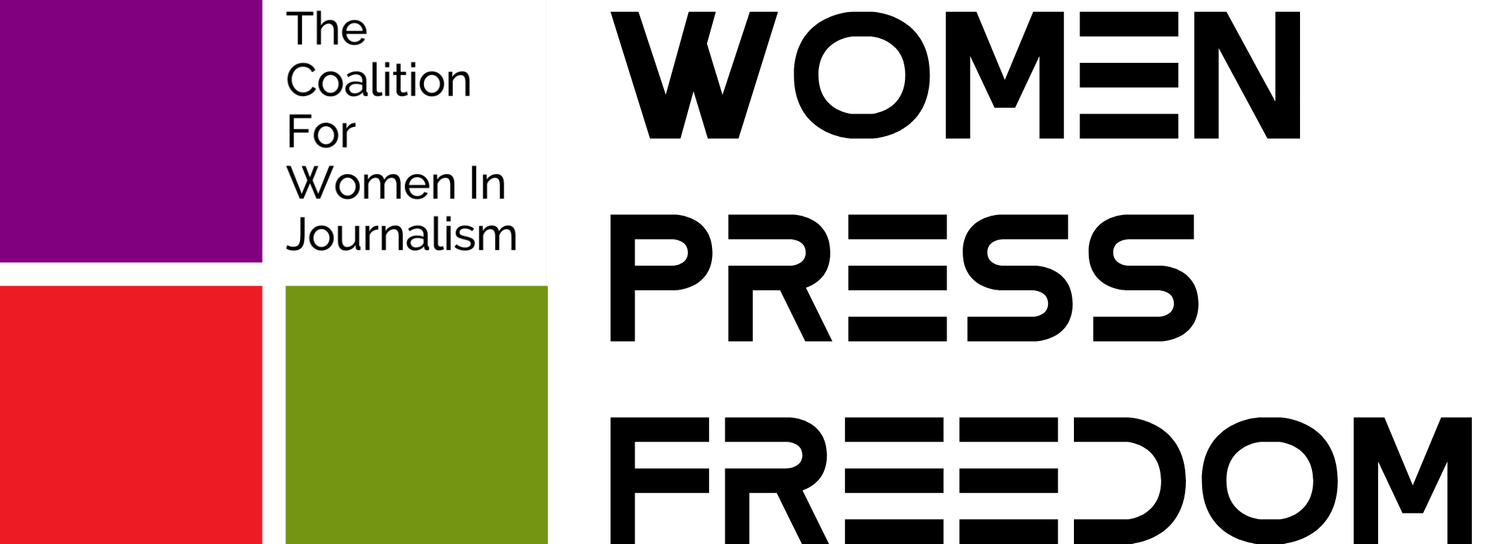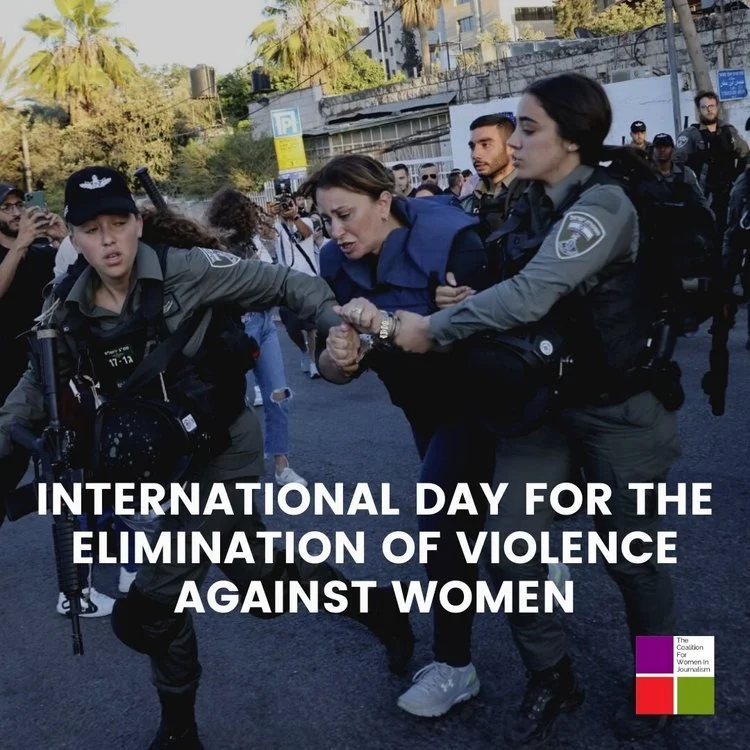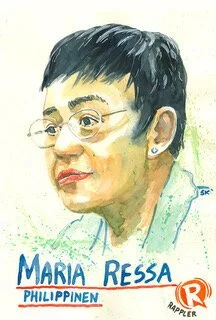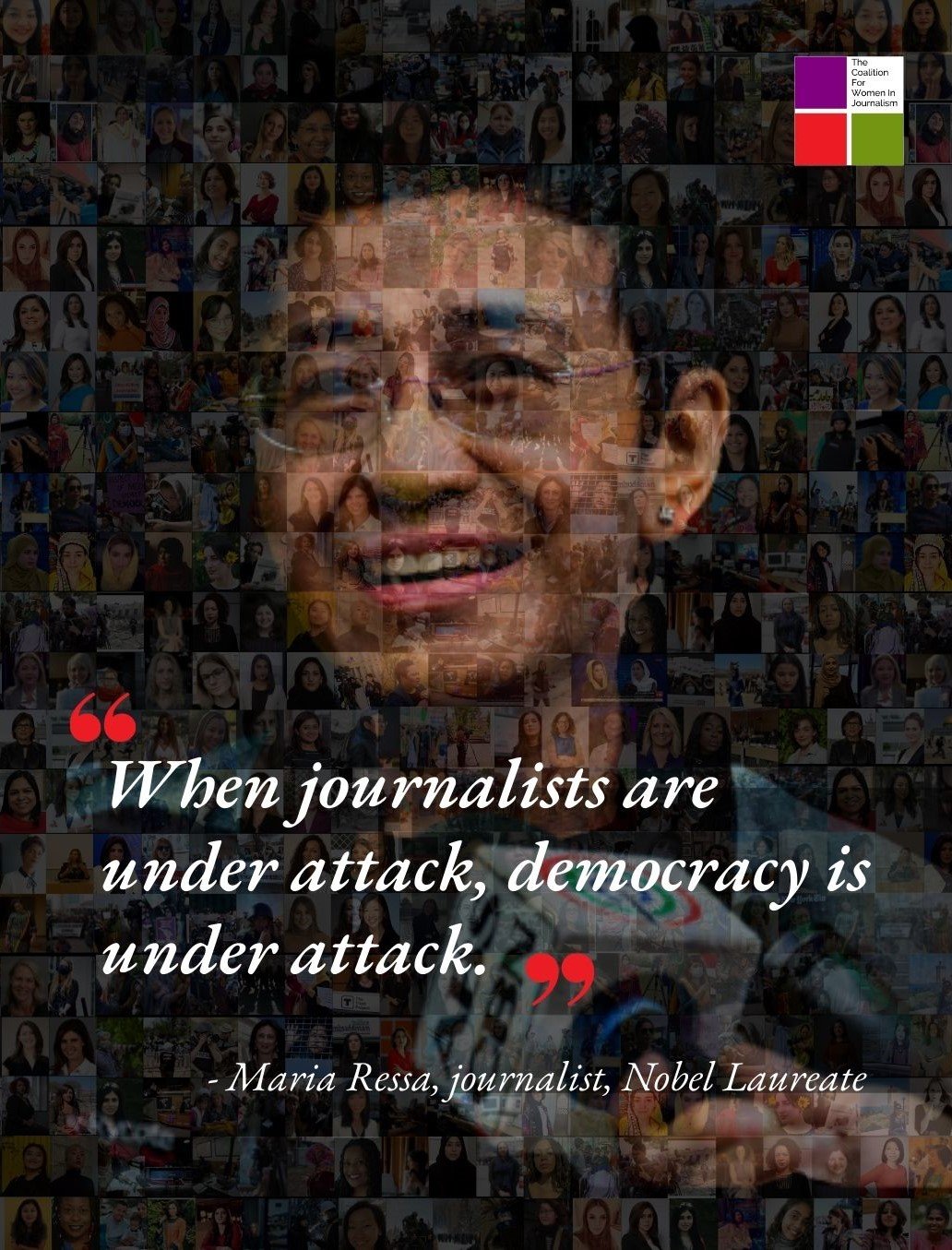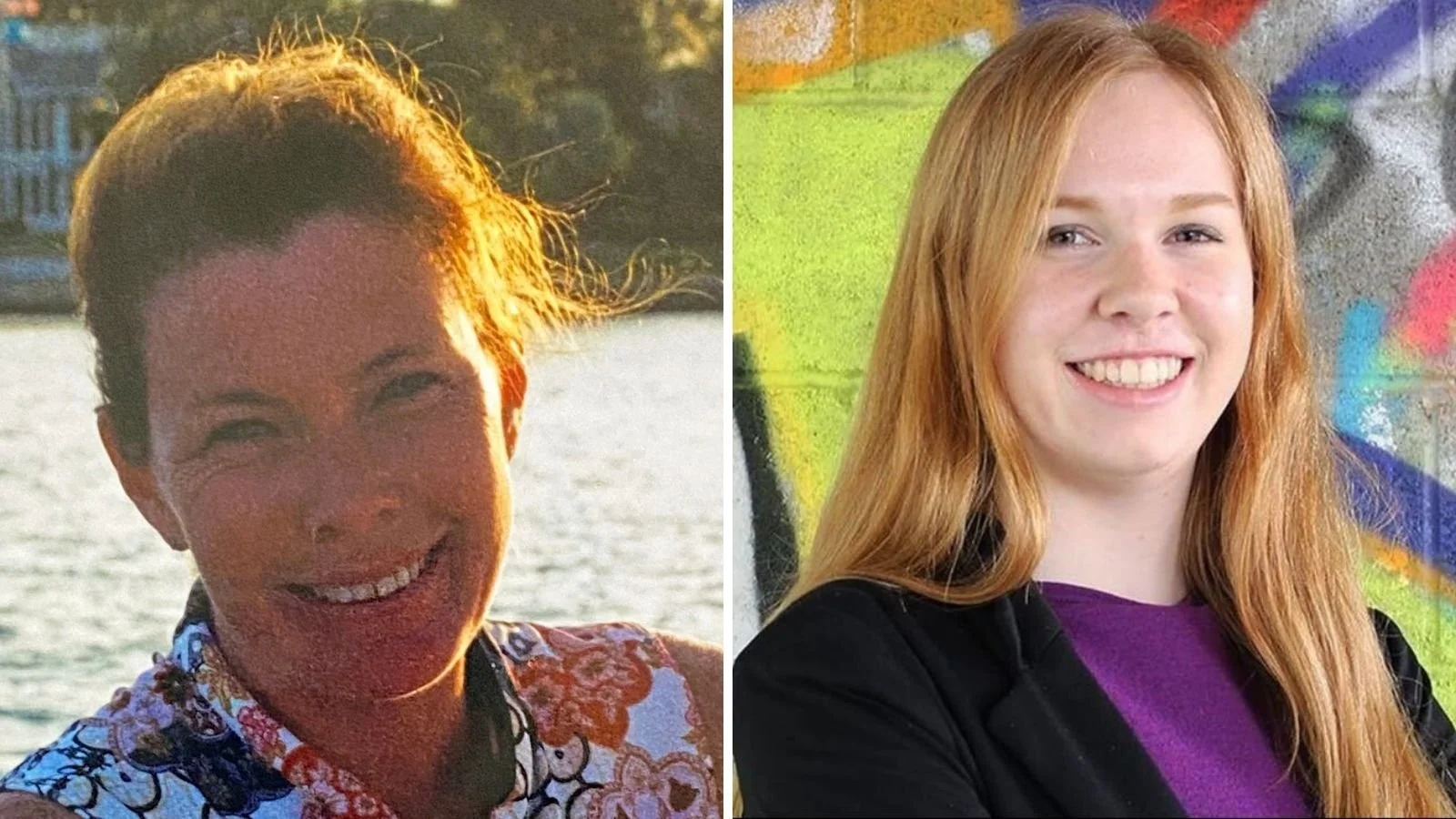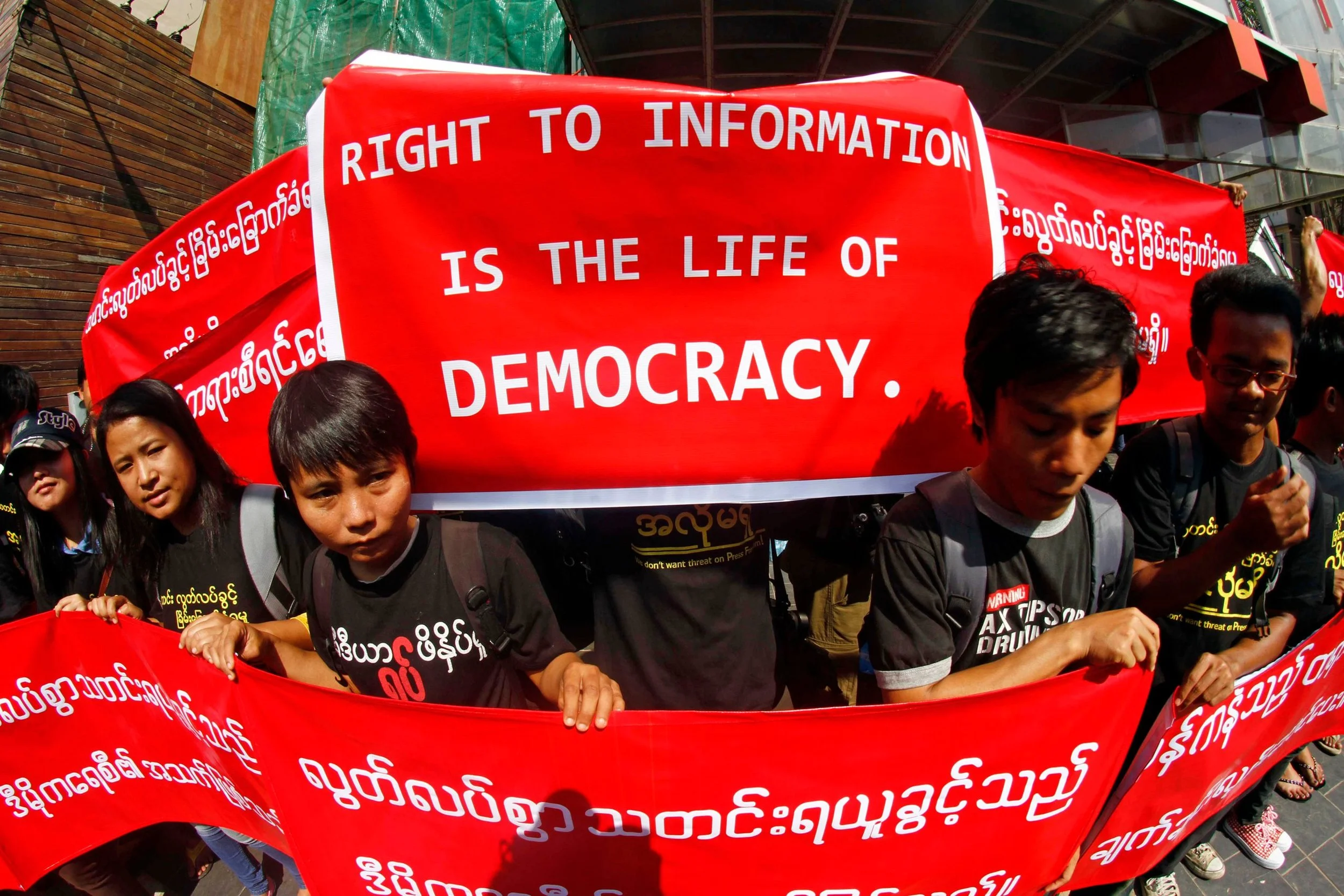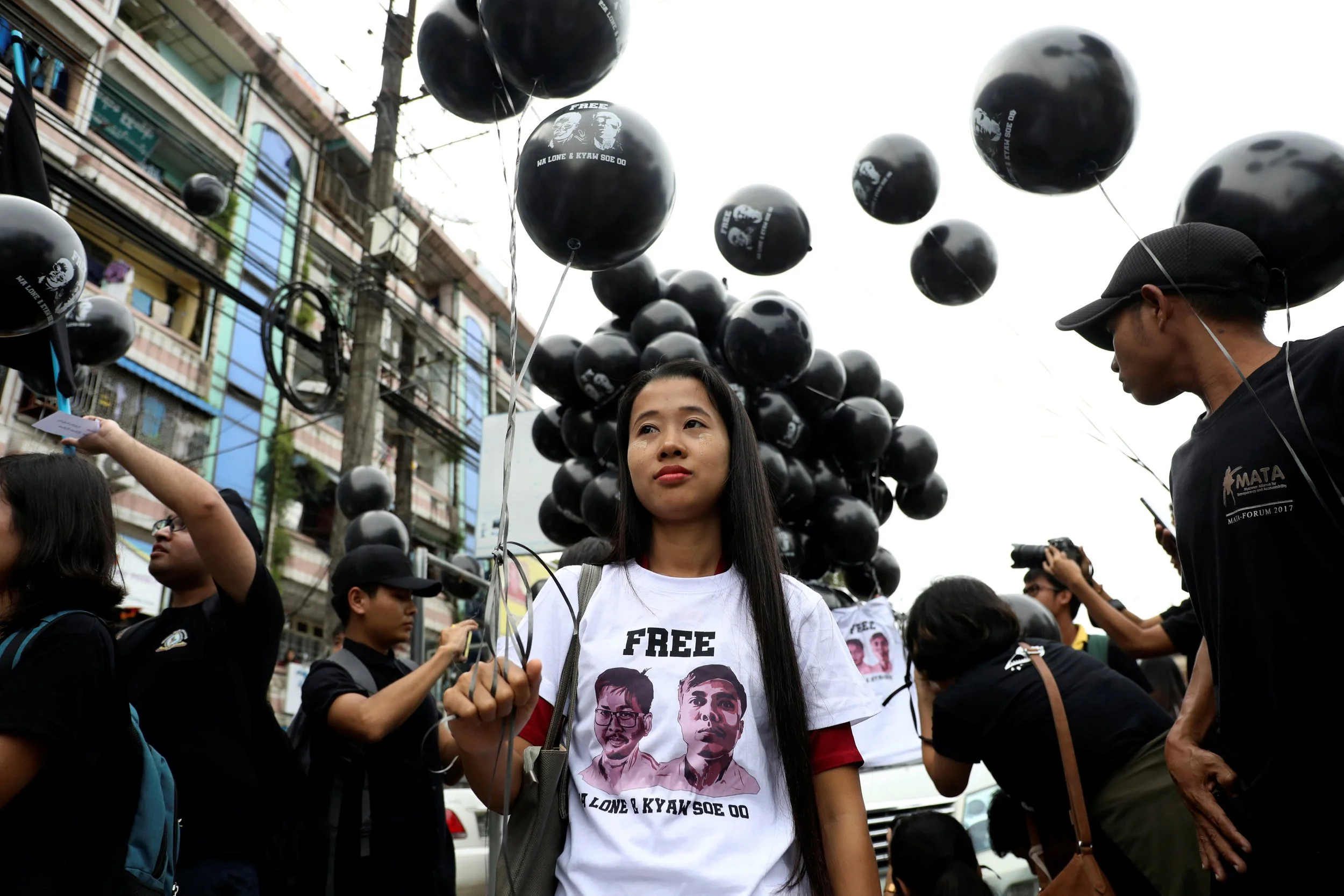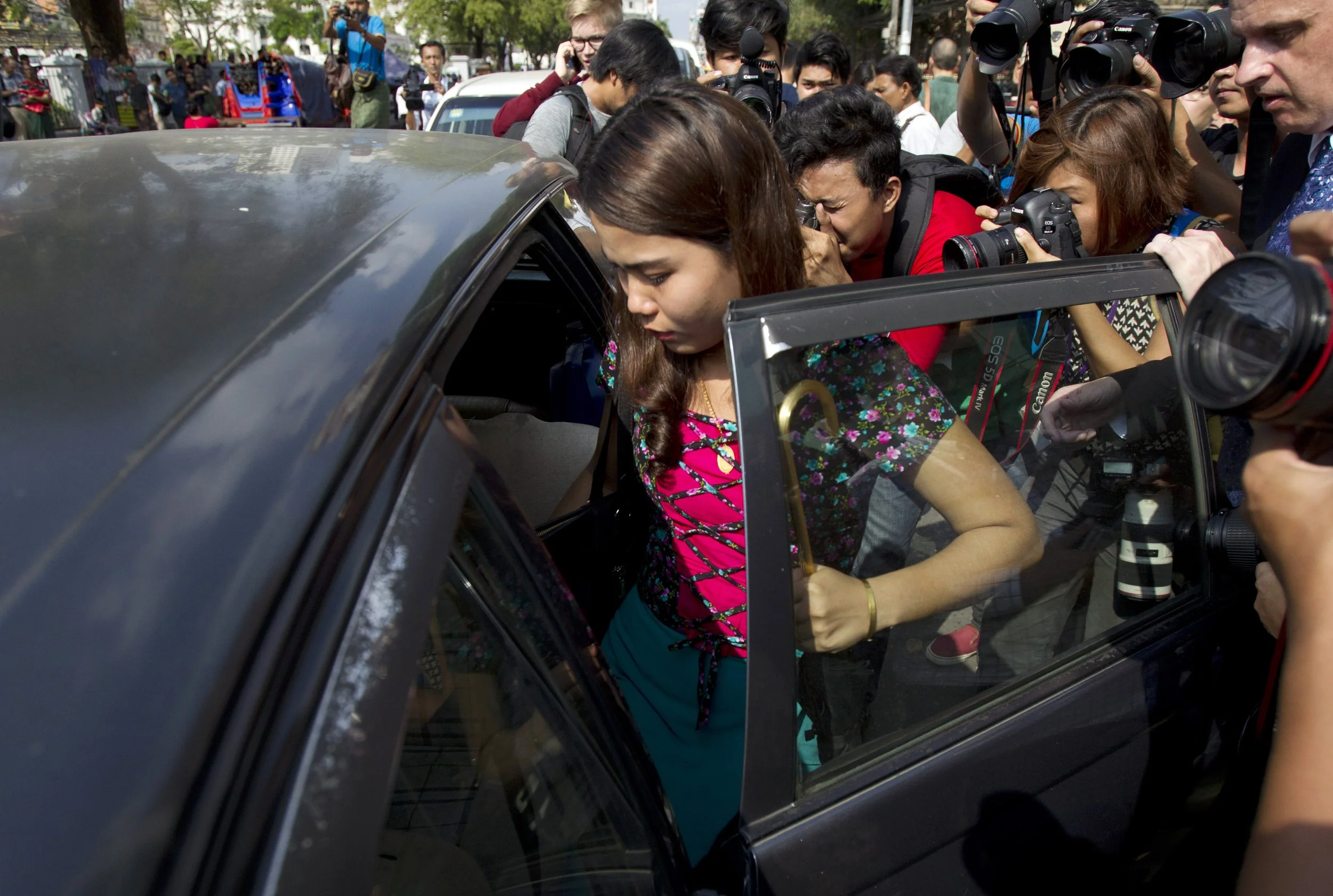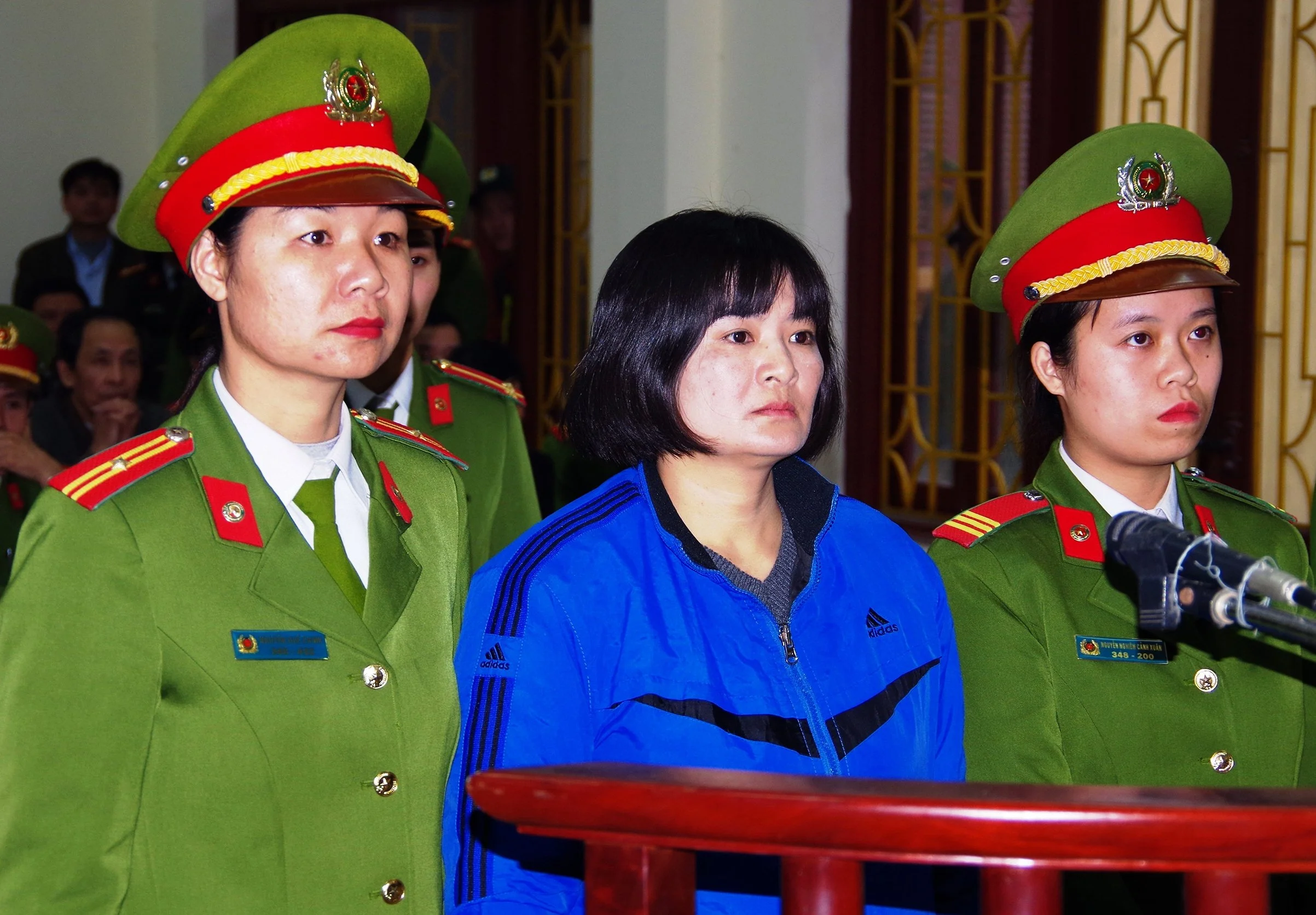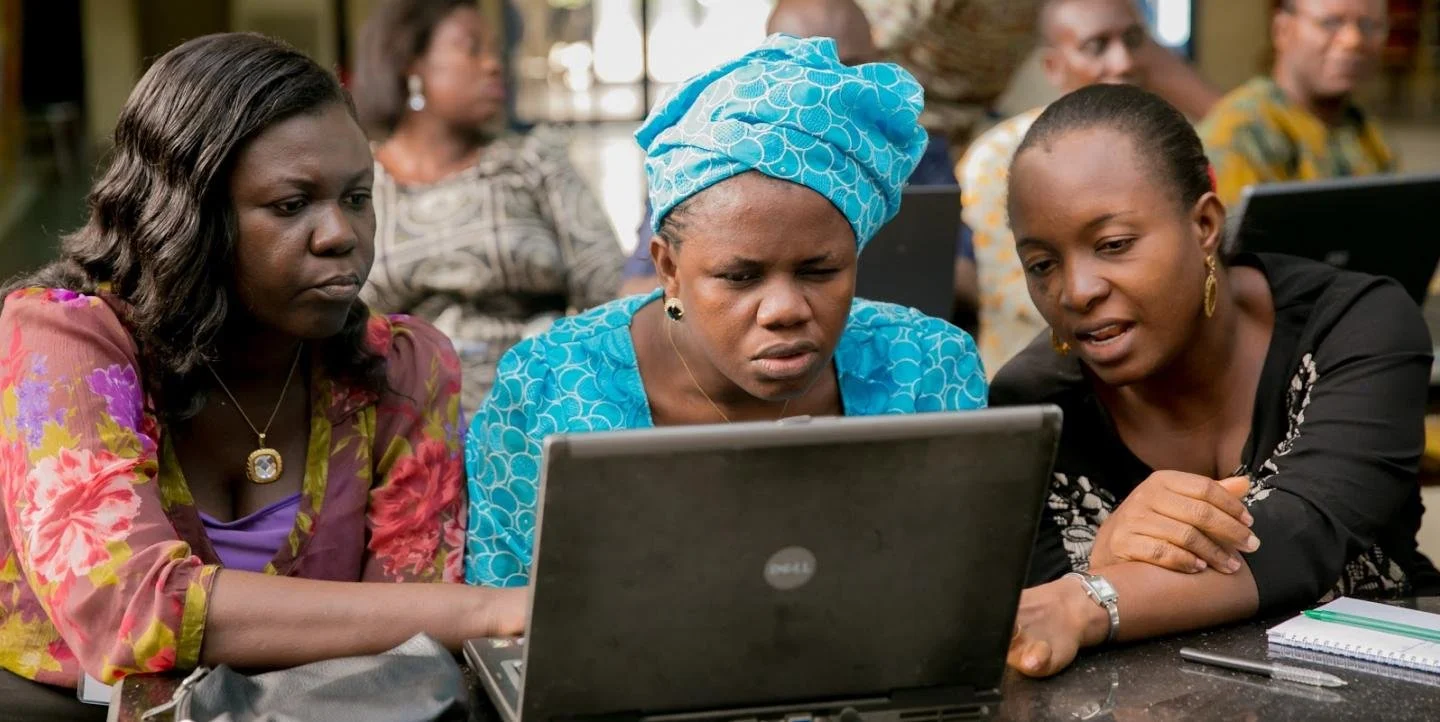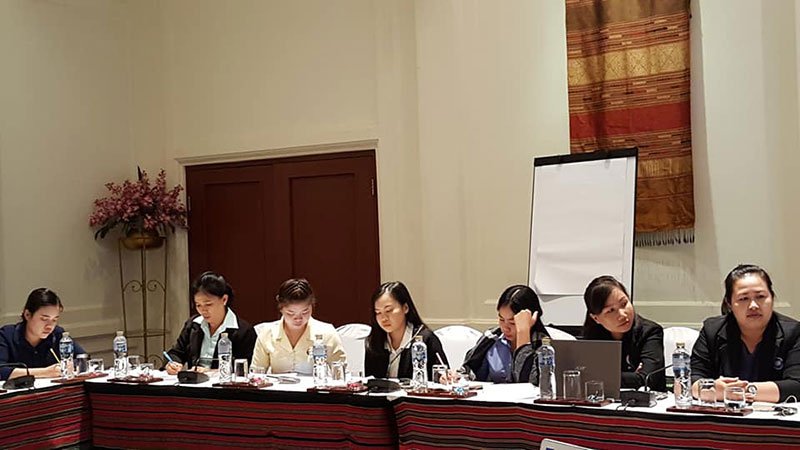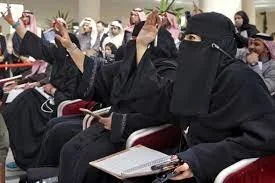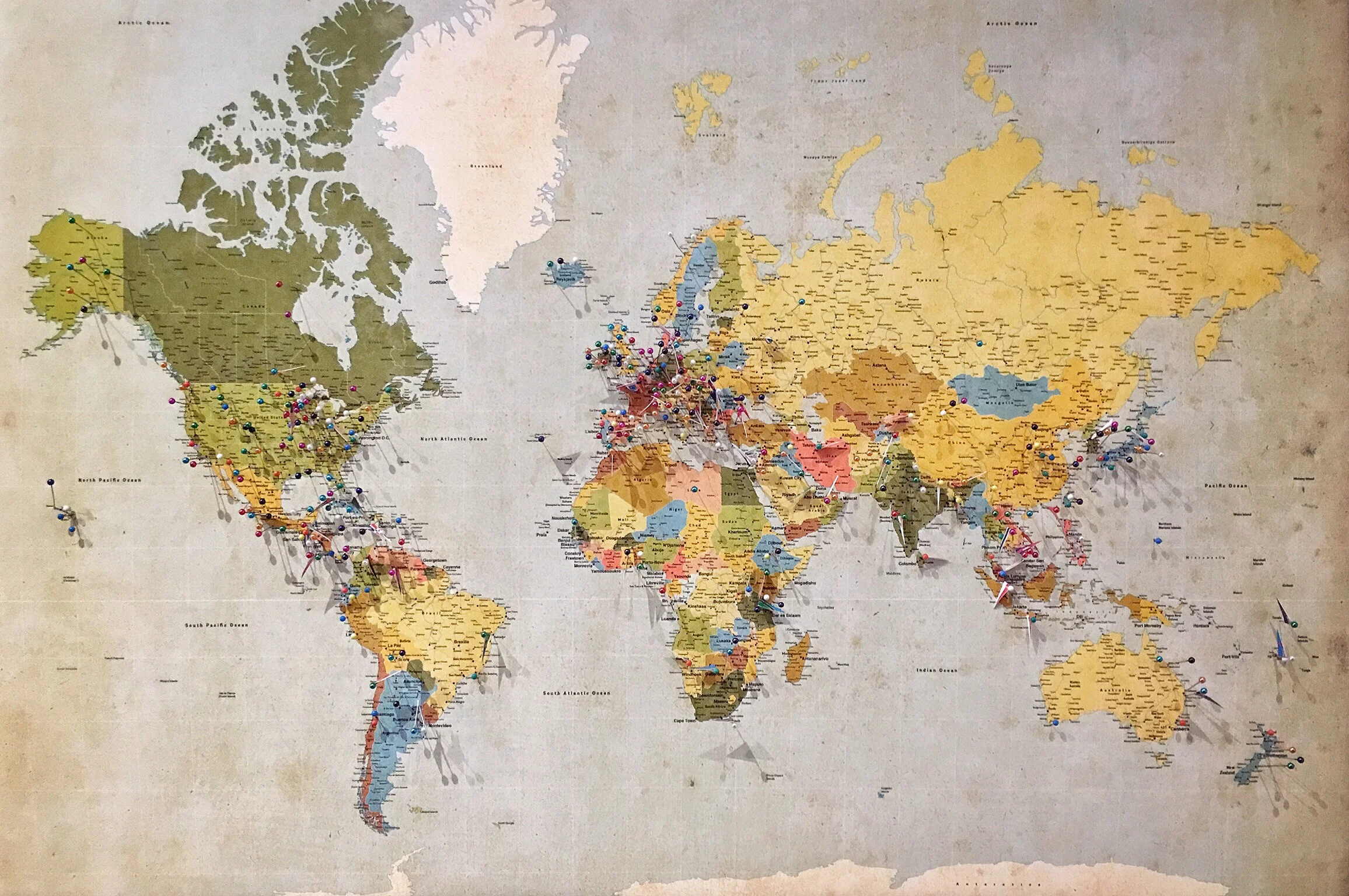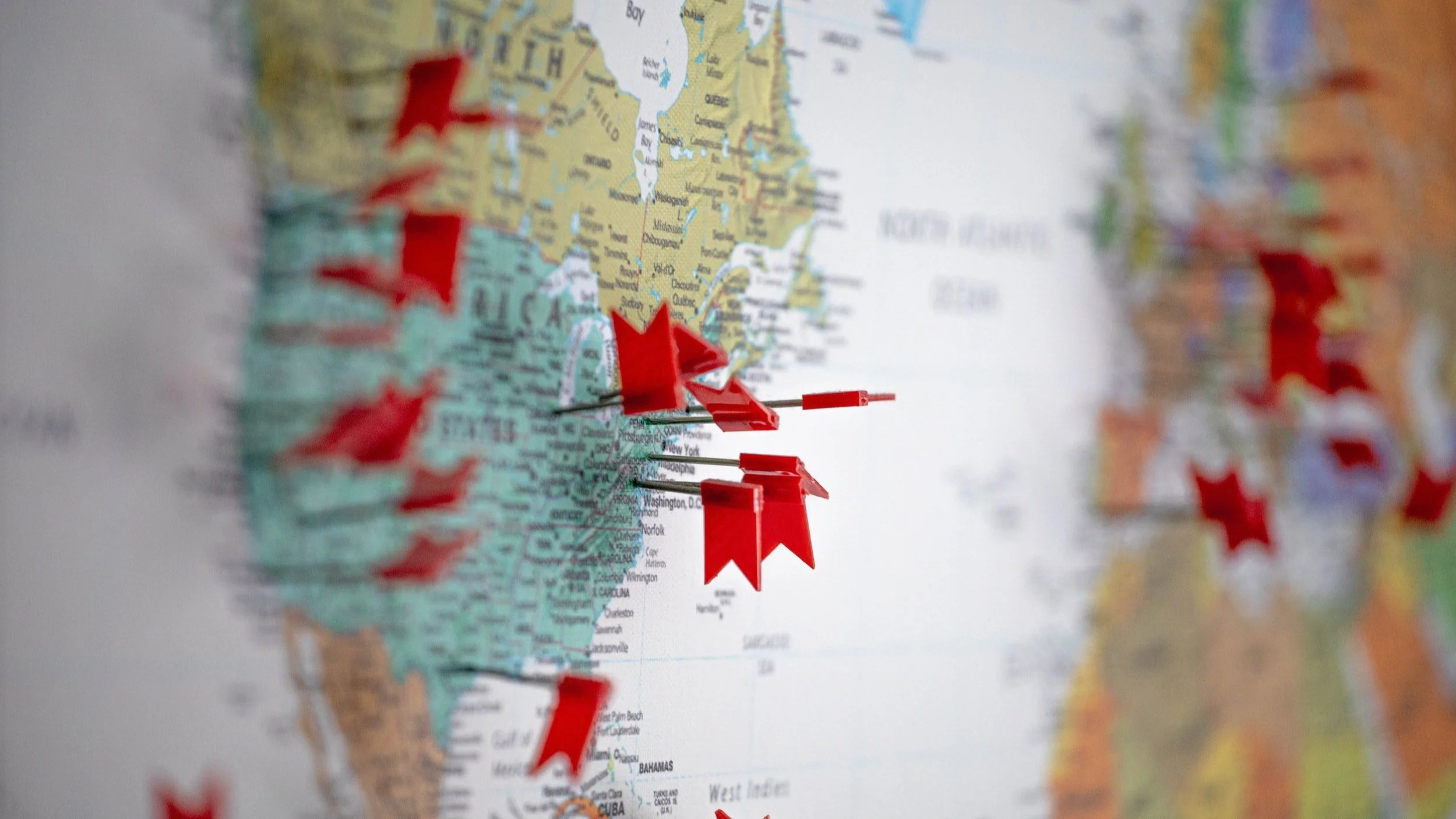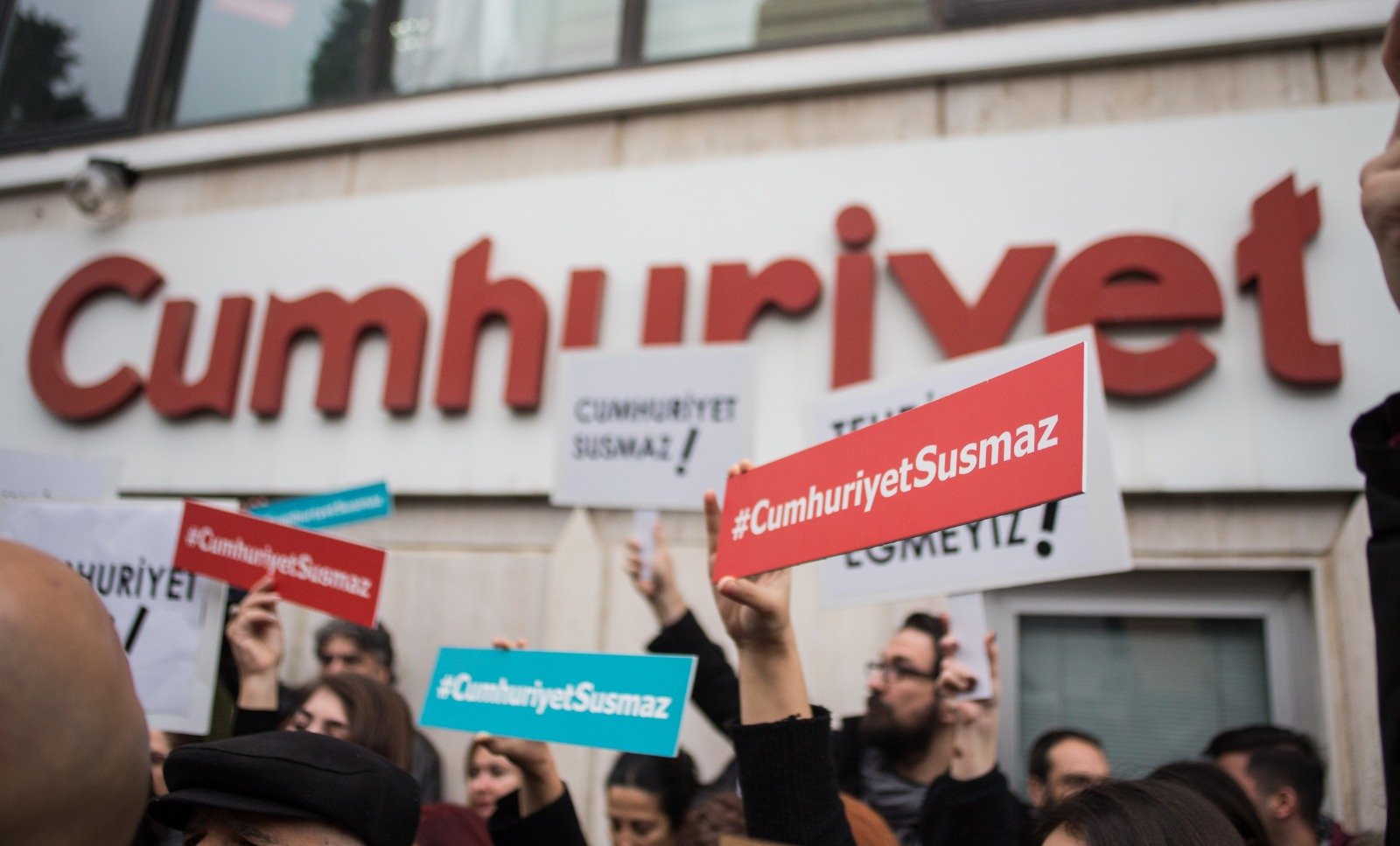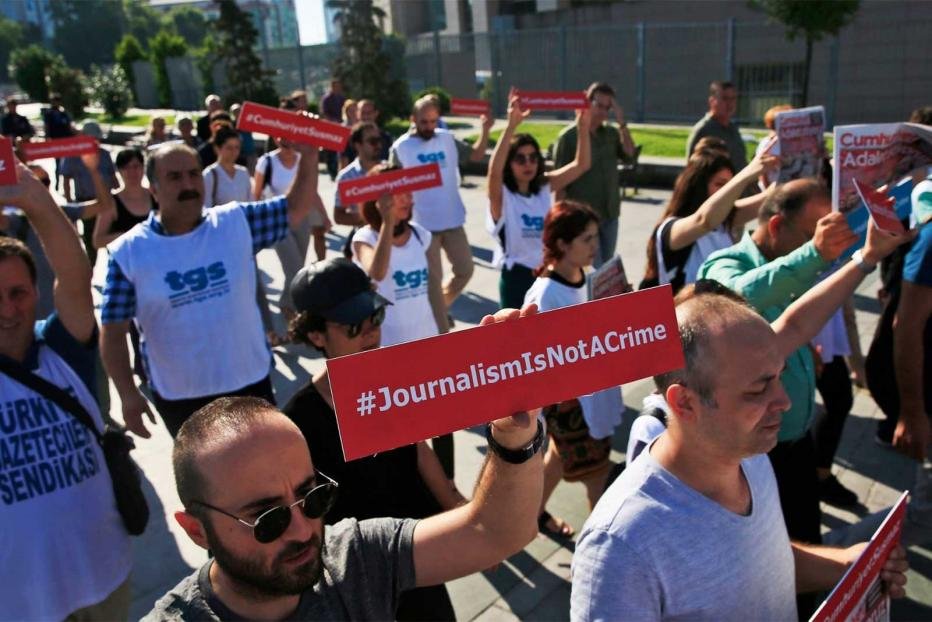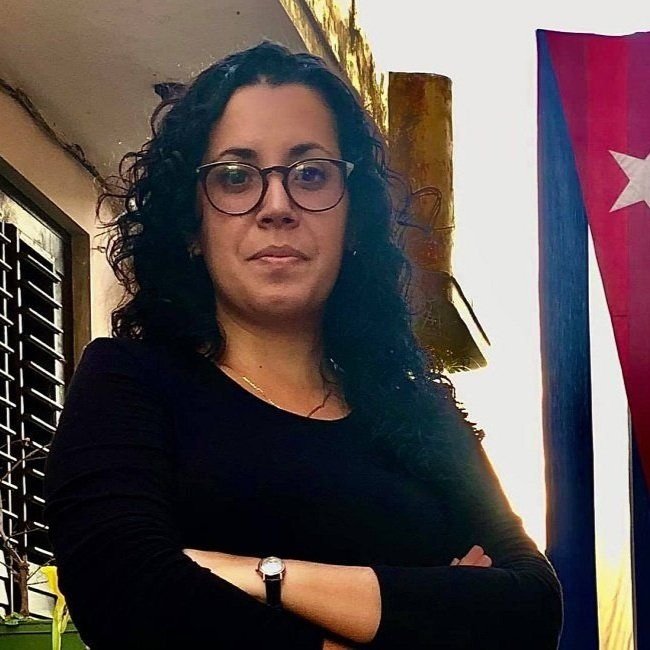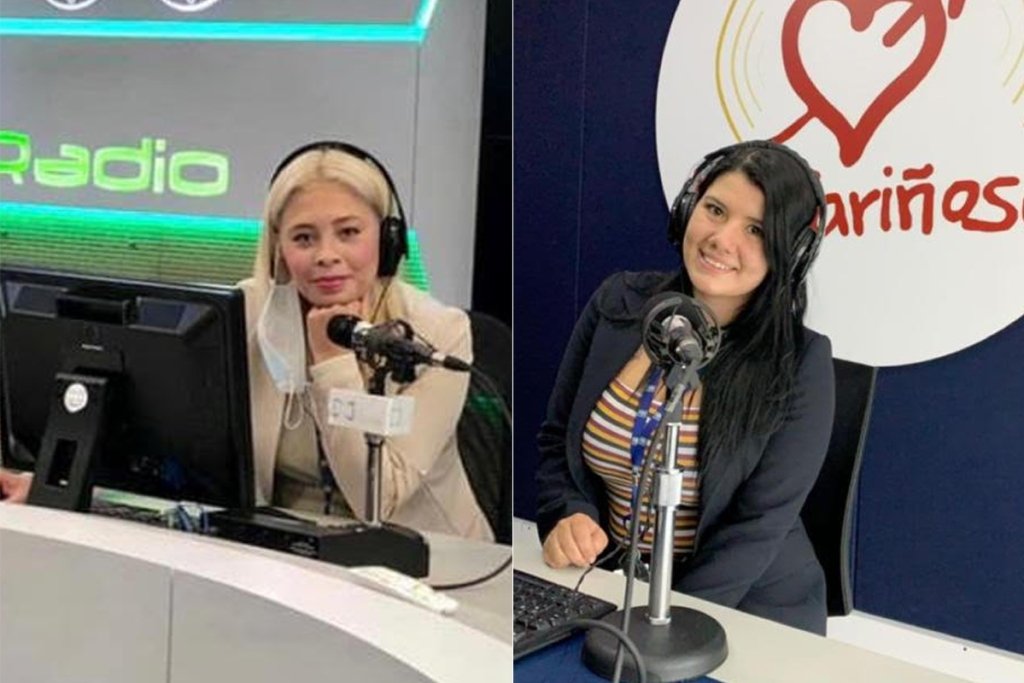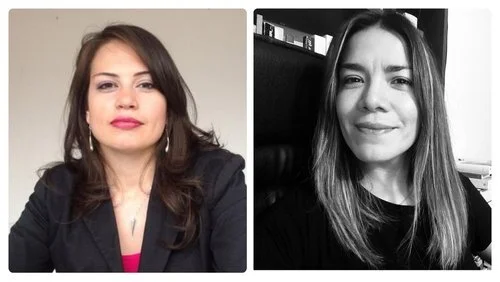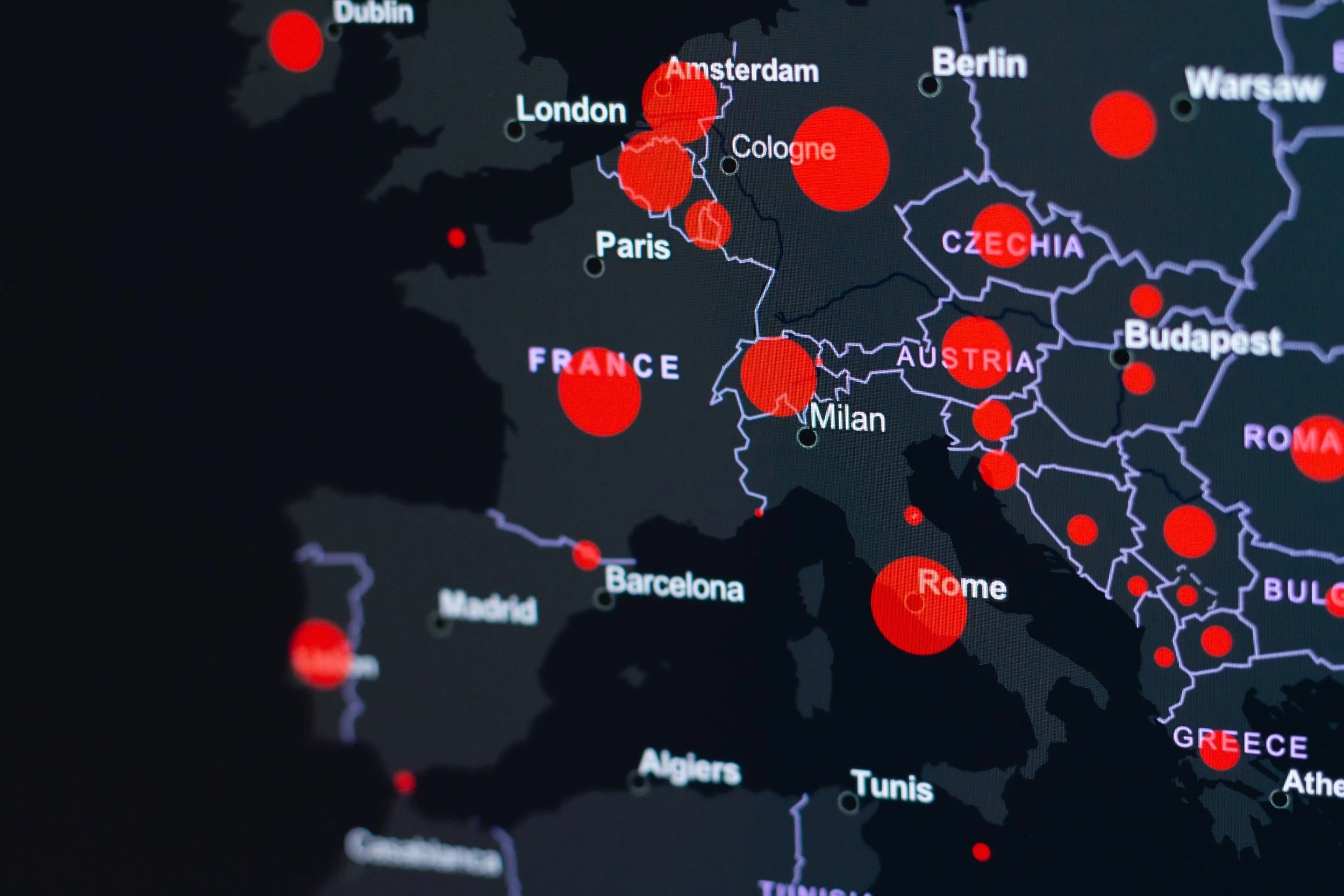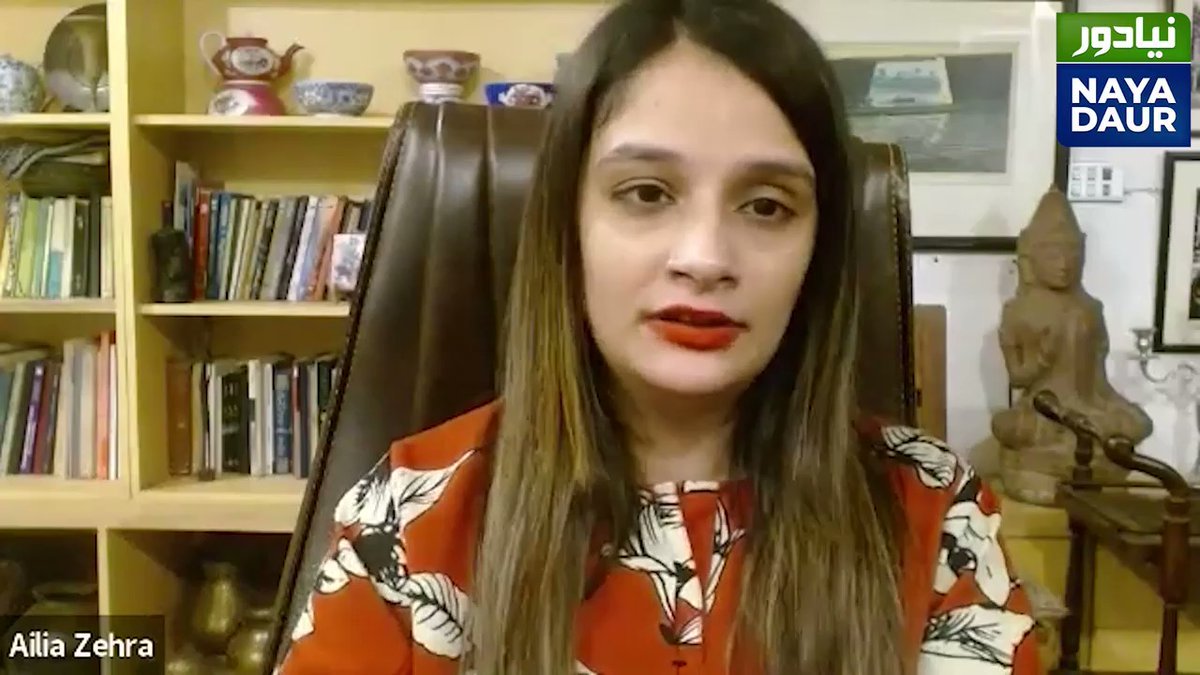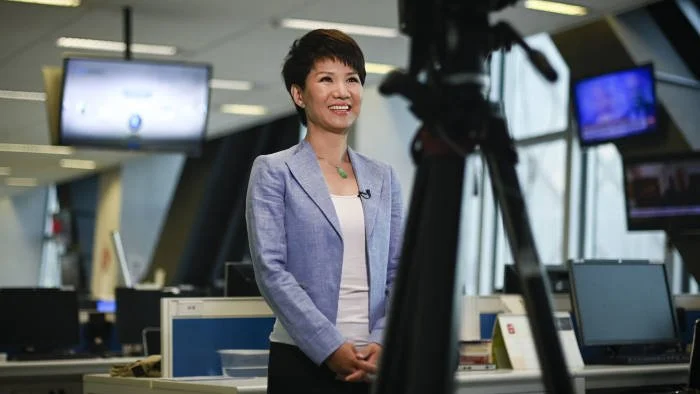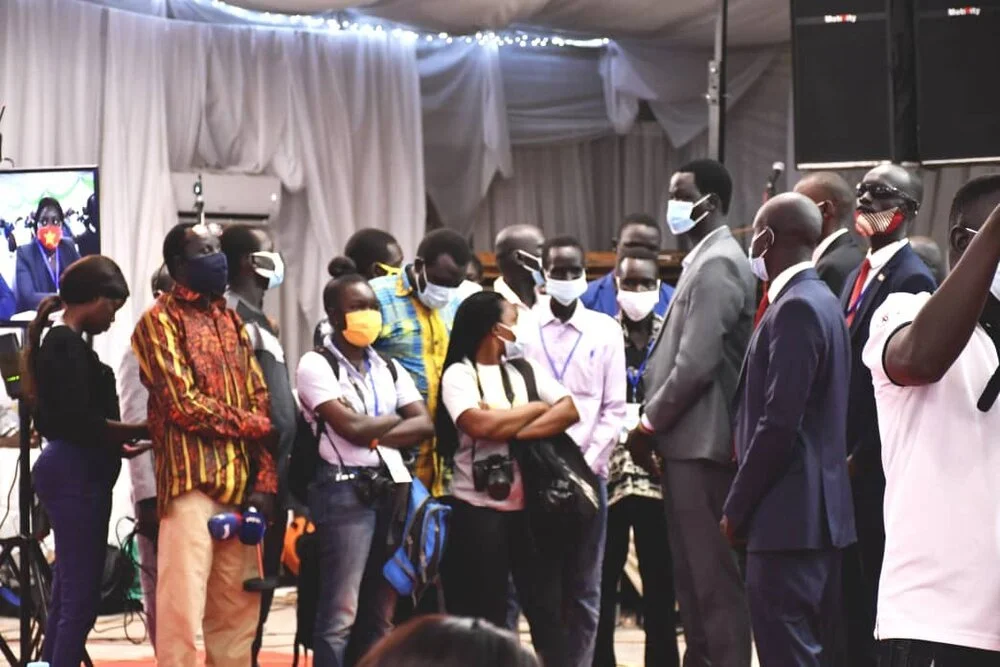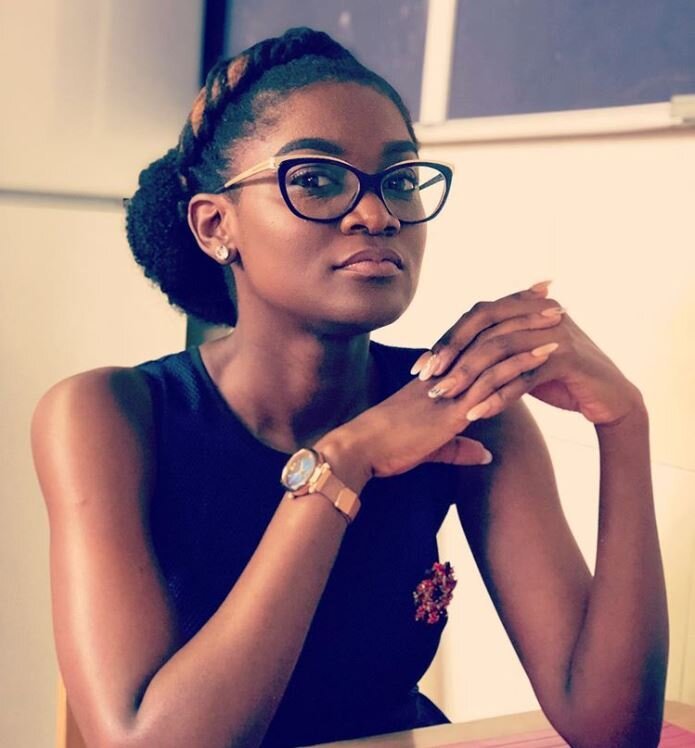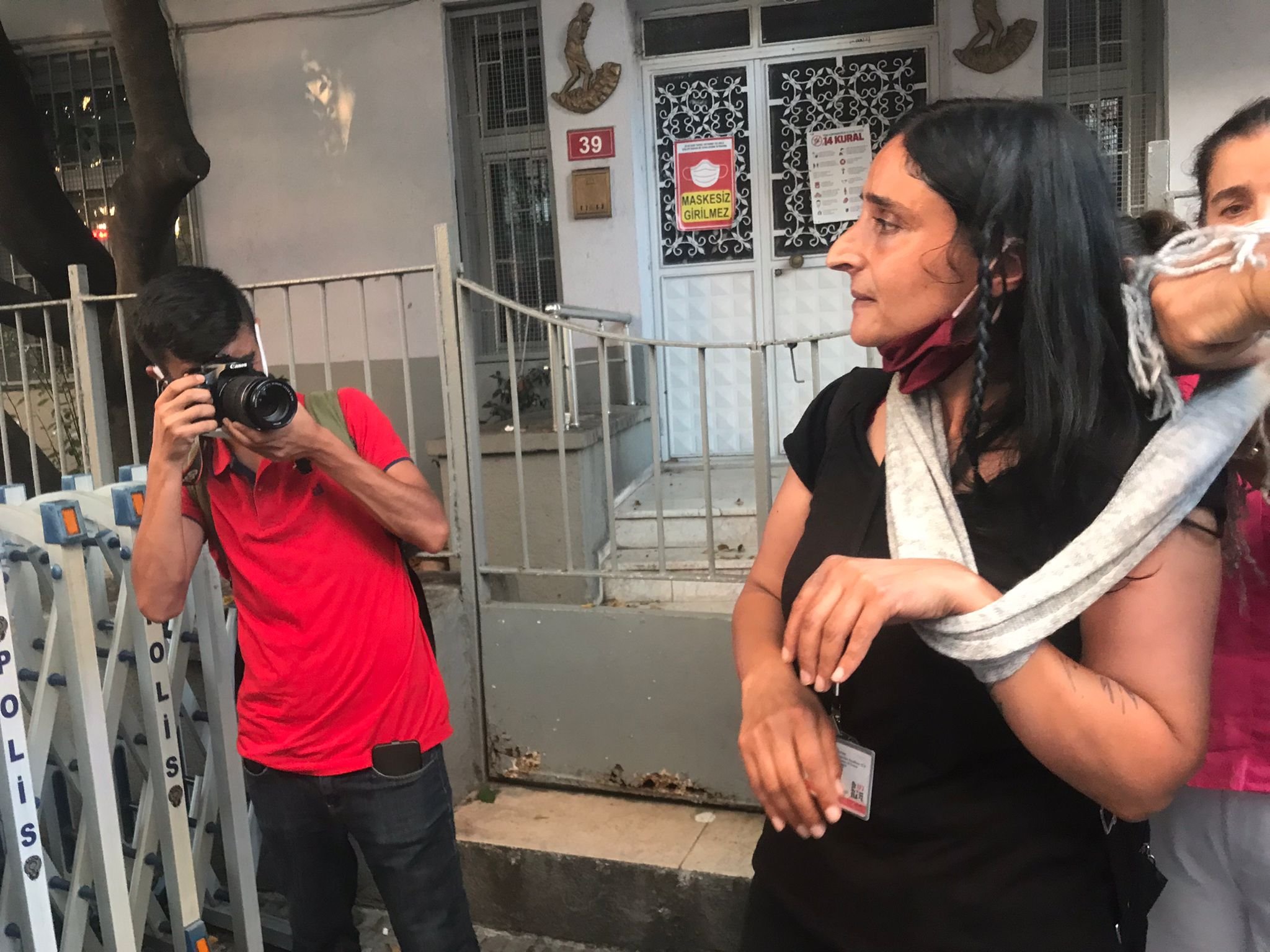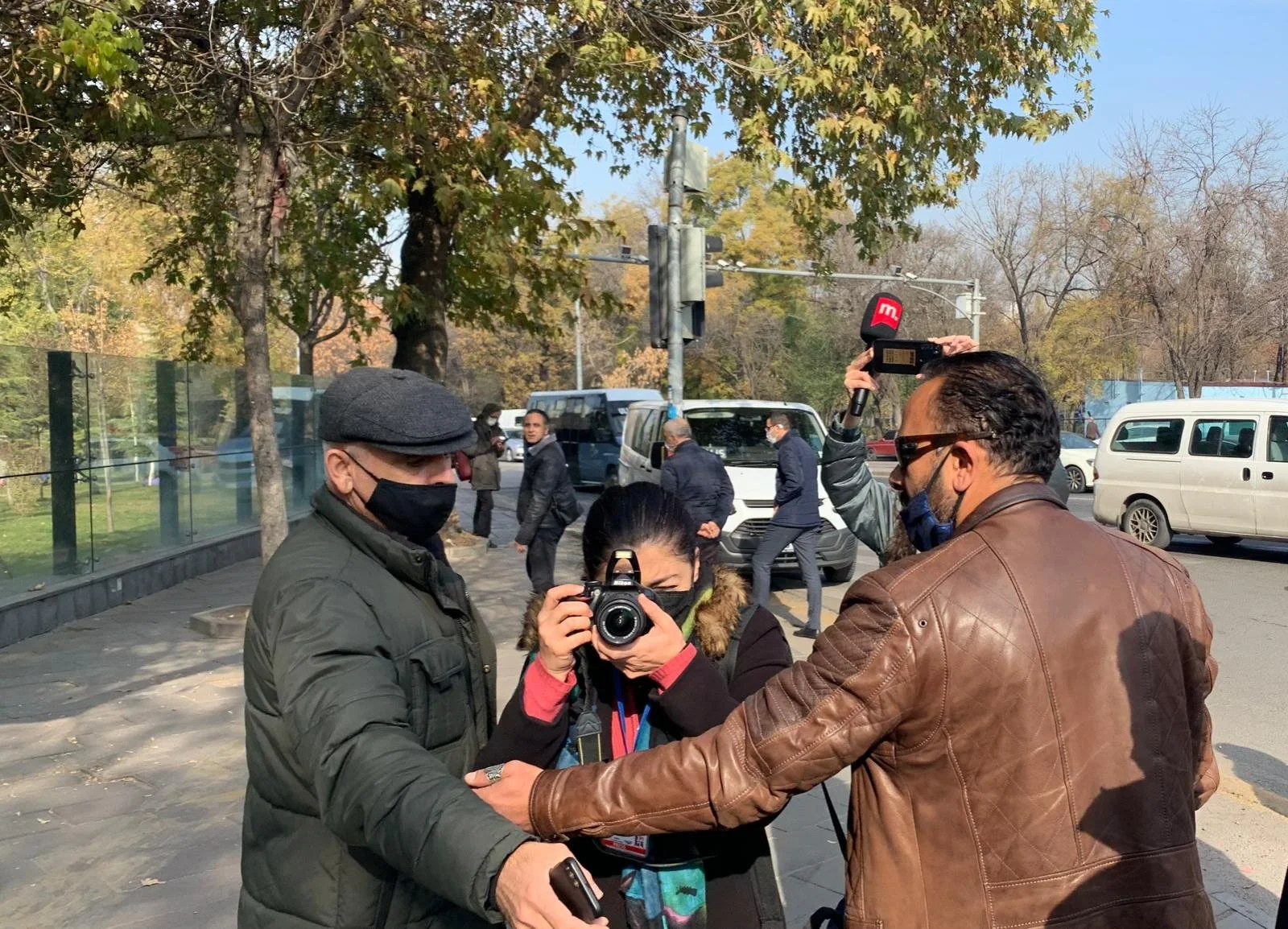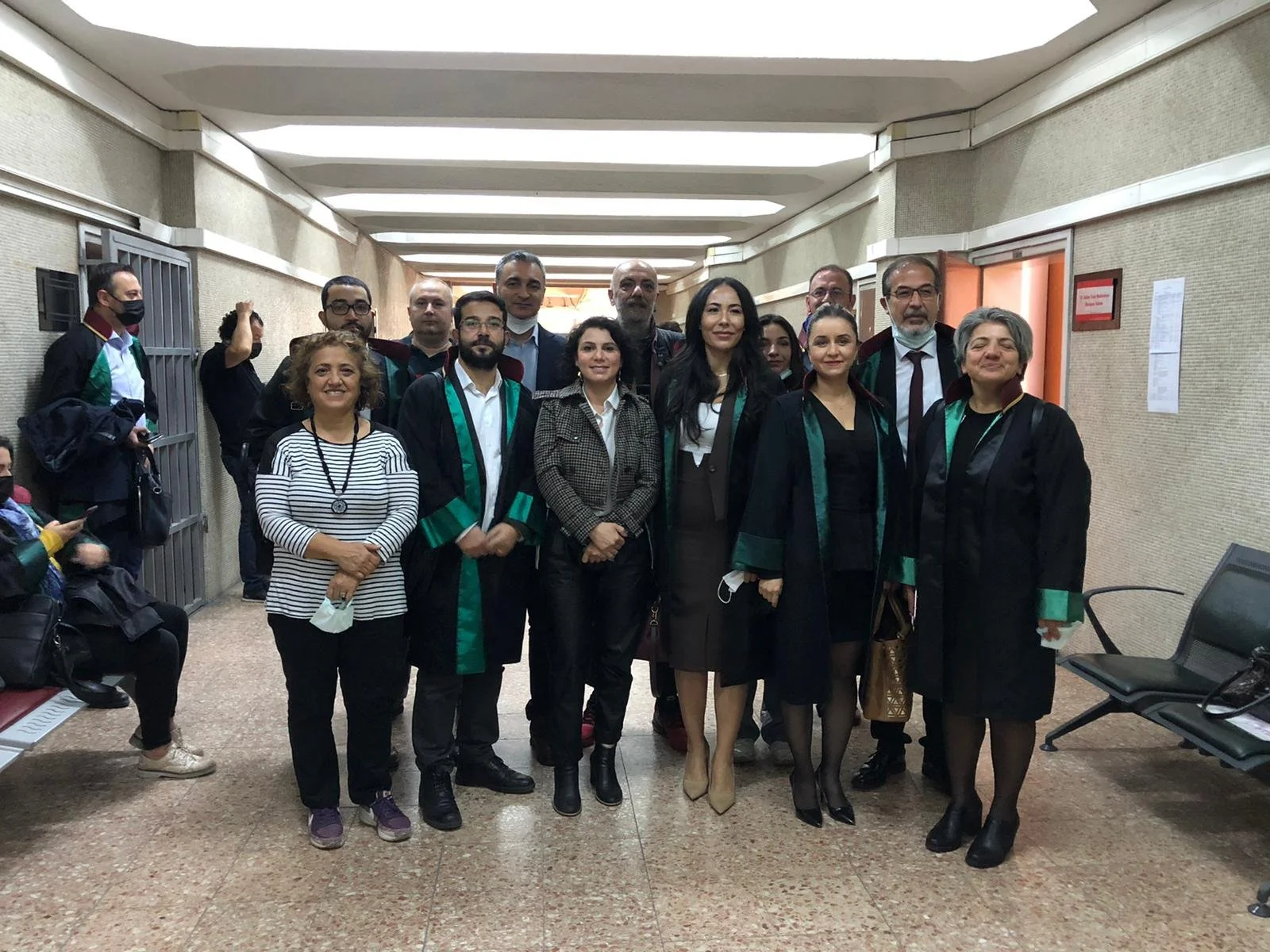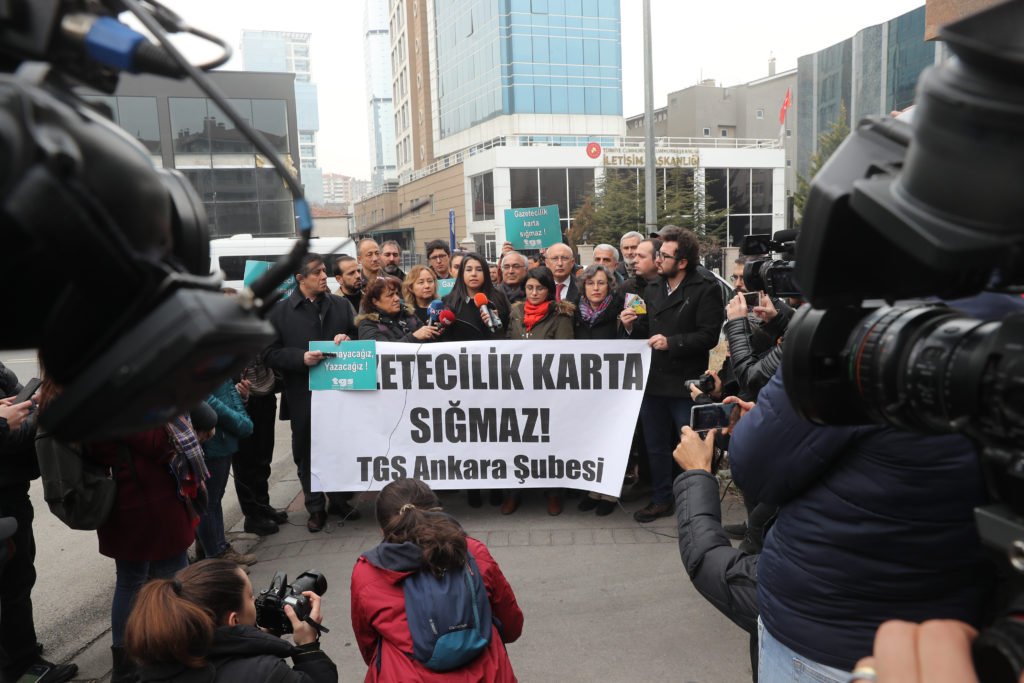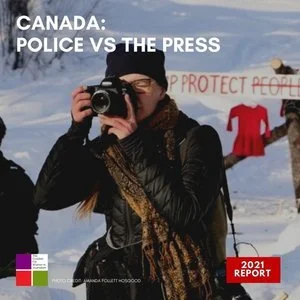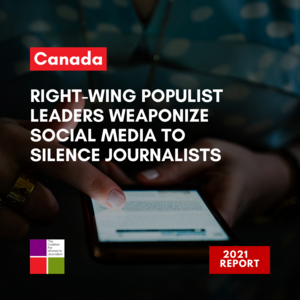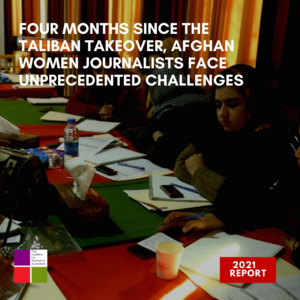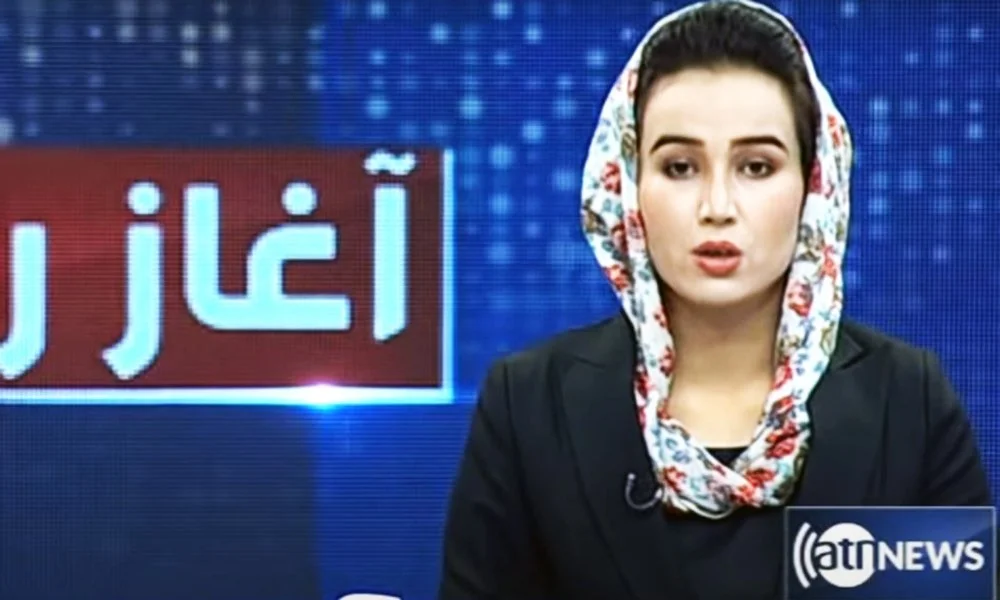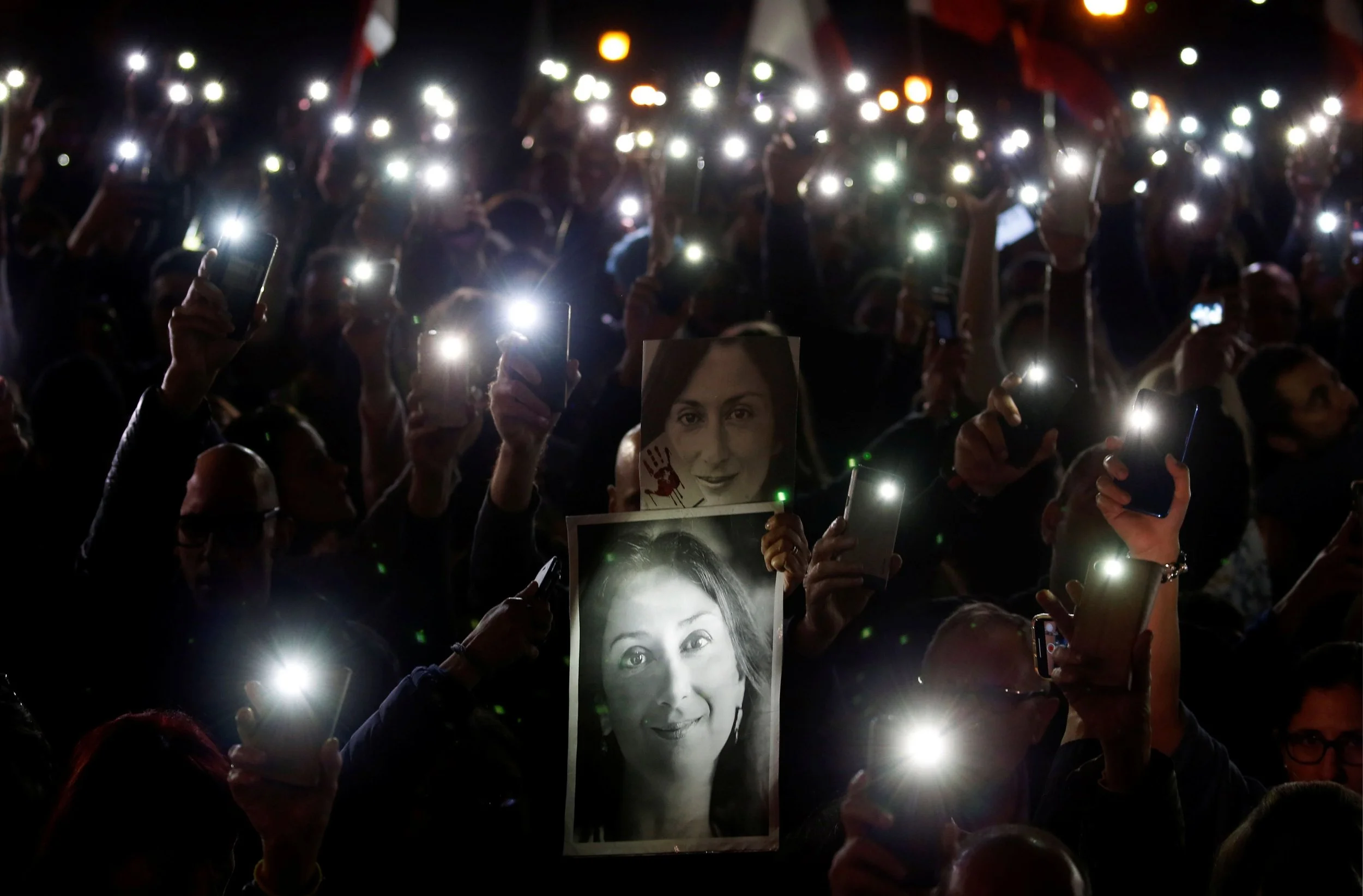2021 Annual Press Freedom Report
The most dangerous but resilient year for women journalists
Murdered Women Journalists in 2021
About CFWIJ
What we do?
The Coalition For Women In Journalism is a global support organization for women journalists. We pioneered a mentorship program for mid-career women journalists across several countries worldwide and are the first organization to focus on the status of free press for women journalists. The CFWIJ brings together journalists and related bodies to cultivate a safe and conducive environment for women journalists globally and help them navigate the industry. Our goal is to build a strong network enabling women journalists to work safely and thrive.
Campaigns
In 2021 the CFWIJ launched several worldwide campaigns to celebrate women journalists, demand justice for women braving severe violations for the right to report freely and independently, defend free speech and ensure the right to information. With our global campaigns and events throughout the year, we aimed to highlight challenges and issues that female reporters face every day and report on violations against them in over 92 countries.
On Human Rights Day, we drew attention to violence against women journalists with a special focus on countries where violations against press freedom escalated in recent months. We launched a powerful campaign on the International Day for the Elimination of Violence Against Women this year and called on the international community to recognize that for women journalists, job hazards and gender-based violence often amount to the same thing. Our message resonated with women journalists across the globe.
On November 2, the International Day to End Impunity for Crimes Against Journalists, the CFWIJ extended support to women and LGBTQI+ journalists worldwide, who face mistreatment and abuse because of their gender and their reportage. Journalists from around the world joined our campaign to stress that impunity begets violence and demanded justice for crimes against women and LGBTQI+ journalists everywhere.
We paid tribute to all hardworking and dedicated women journalists on International Women’s Day for their extraordinary contributions to press freedom despite having the odds stacked against them. While this year’s edition focused on challenging the current order, the CFWIJ persists in confronting the media industry's ever-present gender bias and inequality. We brought some powerful messages from our network on Women's Day. Women journalists shed light on how they overcome the many obstacles they face in their line of work and shared what drives them to continue striving for press freedom.
On World Press Freedom Day, which stresses journalists' fundamental rights and freedoms, the CFWIJ amplified the violations faced by women journalists. We compiled the threats, attacks and harassment braved by women journalists and provided a comparative analysis of violations witnessed in 2021 and 2020.
Country specific research
The CFWIJ has also focused on specific countries and individual women journalists. We highlighted major events, such as COVID-19, Afghanistan Evacuations, US protests, and others which were crucial for their impact on press freedom. Moreover, we have compiled resourceful lists of women journalists reporting in the MENA region, covering COVID-19 on the frontlines, BLM protests, farmer protests in India, and black women journalists to follow.
Threats and violations against women journalists
In 2021, the CFWIJ revived its Twitter campaign to raise awareness on #ThreatsToWIJ - abbreviated from Threats to Women in Journalism. This campaign, first launched in 2017, focused on amplifying threats faced by women journalists in the industry and in the field. Online harassment, physical assault and threats to families of journalists were common violations faced by women journalists around the world.
Our campaign in 2020 featured a special focus on Pakistan, prompted by the brutal murder of Baloch journalist Shaheena Shaheen and the incessant online trolling of women journalists in the country. The CFWIJ drew attention to vicious social media attacks, doxing and hacking attempts faced by women journalists in Pakistan, often by accounts affiliated to the ruling party and conservative, right-wing constituents. #ThreatsToWIJ made the top 50 trending topics in Pakistan on September 15, 2020.
On September 22, 2020, we launched a global campaign to discuss various forms of threats and attacks against women journalists. The campaign, designed as an interactive chat on Twitter, used the #ThreatsToWIJ hashtag to bring together women journalists, activists and rights advocates. This platform facilitated journalists to share their testimonies and propose remedies to enable women journalists to perform their jobs in a free and safe environment.
Monthly reports
In 2020 the CFWIJ also started publishing monthly reports, generating a monthly database of violations against women and LGBTQ+ journalists world over. These reports highlight the different types of cases we identified each month - ranging from arrests and detentions to physical assaults and online harassment. The reports provide periodical markers to what press freedom looks like for female and LGBTQ+ reporters worldwide.
Advocacy
In 2021, we continued this practice, along with building on the advocacy branch of our organization. Launched in 2013, the advocacy branch helps the CFWIJ make the issues and challenges women journalists face every day more visible. Our vigilant monitoring, and diligently collected data, indicate an alarming rise in threats to women and LGBTQ+ journalists worldwide.
2. Objective Of The Report
This report presents a review of the threats women journalists have faced in 2021. Throughout the year, the CFWIJ monitored many cases of violence and threats against women journalists. The year 2021 saw an escalation of violations against women journalists who were subjected to violence both online and offline. We reported on devastating killings, kidnappings, imprisonments, legal and physical harassment, attacks in the field, state suppression, sexist attacks, and numerous other violations that endanger press freedom. The CFWIJ documented attempts by oppressive regimes aiming to silence critical journalists through threats, intimidation and the weaponization of law and state institutions. The report reflects the deteriorating conditions in which women journalists continue to work and how they remain vulnerable to attacks on them.
The CFWIJ has prepared this report using first-hand information, public-access news, and updates from different regions across the world. Cases that have not been publicly reported have been excluded from this document to maintain the individual’s privacy.
This report was supported by Craig Newmark Philanthropies.
Executive Editor: Kiran Nazish
Editor: Jaza Aqil
Data, research and writing: Aimun Faisal, Ayesha Khalid, Ceren İskit, Damla Tarhan Durmuş, Dia Morina, Jaza Aqil
Design: Damla Tarhan Durmuş
Overview: Major violations against women journalists in 2021
In 2021, violations and threats against women journalists were increased by 13.6% compared to 2020.
Ma Hmu Yadanar Khet Moh Moh Tun, a video journalist with the Myanmar Pressphoto Agency, and her colleague, photographer Kaung Sett Lin, were critically injured and subsequently arrested by the military forces while covering a peaceful anti-regime protest in Yangon on December 10, 2021.
The year 2021 presented a bleak picture for press freedom worldwide. The CFWIJ recorded a total of 831 cases of violations against women journalists throughout the year. A sharp increase since 2020 when we witnessed 731 such cases. We saw the number of incarcerated women media workers reach a record high - as many as 63 remained behind bars on December 31, according to the CFWIJ’s findings, with at least 20 women journalists jailed in 2021 alone. At least 12 women journalists were killed while numerous others were subjected to various forms of state suppression, legal harassment by state and non-state actors, physical assualts and harassment, sexual assaults and harassment, and online violence.
The economic toll of Covid-19 that hit in 2020 carried forward to 2021 along with the health and social implications of the pandemic. Even as countries and newsrooms adapted to intermittent tightening and easing of restrictions, women journalists worldwide continued to bear the brunt of increased care work alongside the demanding nature of the job. And yet, they reported on the pandemic from the frontlines, responding to the situation each time the pandemic reared its head in the form of a new variant, and kept citizens well informed. For many, this came at the cost of their own safety. Threats by the virus aside, critical journalists were also forced to deal with government retaliation for exposing mishandling of the pandemic, monetary irregularities and graft, and for merely holding elected representatives accountable for their actions to secure public health. Prominent among these were the cases of Zhang Zhan in China and Rozina Islam in Bangladesh, with the former yet languishing in prison even as her health deterioates dangerously, and the latter continuing to face legal harassment at the hands of the state. In both cases, the only crime the journalists committed was questioning their respective government’s mishandling of the pandemic.
When speaking of legal harassment of journalists at the hands of the state, one cannot ignore the trials and tribulations of Maria Ressa in the Philippines. In October, the CFWIJ welcomed the decision of the Norwegian Nobel Committee to honor Maria with the prestigious Nobel Prize for her “efforts to safeguard freedom of expression, which is a precondition for democracy and lasting peace”. Maria has been a vociferous critic of the President Rodrigo Duterte’s government and the deadly “war on drugs” he launched in 2016. For repeatedly holding power to account, the Nobel Laureate and her team have been targeted with a series of state-linked legal cases, investigations and online attacks. Even as the committee recognized Maria as a representative of all journalists who stand for freedom of expression and press freedom, a senior member of the Philippine cabinet filed a new libel against Rappler, a digital media company for investigative journalism, which she co-founded in 2012 and still heads. This lawsuit is the eighth active legal case against Maria brought by the state. Her legal battles in seven cases, including an appeal against her 2020 conviction for criminal cyber libel, in which she faces up to six years in prison, are still ongoing.
Far from acting as a deterrent, however, the Philippine government’s long drawn out legal battles with Maria, have only made her bolder and stronger. In December, as she collected her award, after thwarting the state’s attempts to prevent her from traveling to Oslo, Maria stood tall and defiant as a defender of the free press. Her story, though prominent, is not an isolated one. In 2021 alone, the CFWIJ documented over 175 cases of women journalists being subjected to legal harassment for their reportage.
Throughout the year, we saw legal harassment employed as a common tactic to gag critical journalists. Under the garb of anti-terrorism laws, increased censorship ostensibly to counter “fake news” and the pandemic, oppressive regimes sought to embroil critical journalists and dissenting voices in legal battles. In several cases, as in the case of Turkey, this led to women journalists landing in pretrial detention or facing prolonged prison sentences. In Iran, we saw the arrests of Rahil Mousavi, Mehrnoush Tafian and Narges Mohammadi, whereas in India we saw legal charges brought forth against Rana Ayub and Barkha Dutt, among others. In Russia, the draconian “foreign agents” law was liberally employed to engage women journalists in legal battles.
Moreover, states around the world continued to introduce new laws to encroach on the freedom of the press. China introduced fresh curbs banning private investment in media houses and broadcasting, El Salvador president proposed a new law - similar to one we have seen abused in Russia - requiring media outlets and journalists with foreign sources of funding or income to register as “foreign agents”, the Nigerian government banned Twitter and Pakistan introduced repressive Pakistan Media Development Authority while Ethiopia ramped up arrests to squash coverage on the on-going civil war in the country.
Apart from state suppression in the form of legal harassment and imprisonment, women journalists also faced threats from other state-linked institutions. We recorded instances of police and military violence against female media workers as well as slander campaigns run by pro-government media outlets against critical journalists and abductions. In Myanmar, for instance, the military junta resorted to brute force against journalists critiquing the February coup and reporting on protests against the military regime. The deeply concerning violations faced by Ma Thuzar, Thin Thin Aung, Myo Myat Myat Pan, Kay Zon Nwe and Ma Hmu Yadanar Khet Moh Moh Tun stand as testament to the dangers facing women journalists in the country.
Threats to women journalists increased world over not just in the physical space but also in the online realm. The rise of right-wing populists and increasing polarization of societies across the globe coupled with rapid spread of misinformation amid lack of regulation by social media giants left women journalists vulnerable to threats both online and offline. At least 96 women journalists were targeted with organized trolling and slander campaigns online in 2021. In several instances, the personal details of women journalists were also made public online thus exposing them to further attacks in the physical space as well.
Appalling examples of risks to women journalists were witnessed in Canada, Argentina and Northern Ireland. According to our findings, Canada proved to be the most hostile virtual space for women journalists in September when over 20 women journalists of color received vile and threatening emails after right-wing politician Maxime Bernier tweeted a provocative message to his followers. Displeased by their coverage of his work, and their line of inquiry, Bernier encouraged his supporters to “play dirty”, sparking a violent and targeted harassment campaign. He even went so far as to publish the email addresses of some of the journalists online, exposing them to online abuse. Although Bernier’s tweets were later taken down by Twitter because they violated community standards, they paved the way for hostile attacks against journalists.
Subsequently, a stark reminder of digital vulnerabilities for those holding power accountable unfolded in Canada. Women journalists were sent racially charged and deeply gendered abuse and threats online by a single malicious email address. Despite widespread condemnation of the attacks, the local authorities did little to prevent or investigate the attacks. The following month, at least five more women journalists of color in the country were targeted online.
Meanwhile, Argentina and Northern Ireland saw the safety of journalists Sandra Borghi and Patricia Devlin, respectively, severely compromised because of attacks on them online. The former was subjected to virtual identity theft, which endangered not just her but also her network of friends and colleagues, while the latter continued to face vile and deeply gendered threats against herself and her minor son.
The deeply gendered nature of threats to women journalists online was both reflective and reflected in violations against women journalists offline. Our reports in 2021 also shed light on the prevalent threat of sexual harassment faced by women journalists. This particular violation, which directly impacts women’s role in the news media industry, is typically brushed under the rug. In the past year, however, several women journalists from different countries around the world came forward with their experiences of surviving sexual misconduct. Throughout the year, the CFWIJ recorded at least 27 cases of women journalists being subjected to some form of sexual harassment while on the job. Shelley Ross in the United States, Greta Beccaglia in Italy, and Mariana Romero and Carolina Ponce de Leon in Argentina, stand as recent examples. Moreover, the CFWIJ also documented instances of accused harassers being appointed to positions of power for example M Radhakrishnan in India.
The year 2021 saw multiple threats to women journalists apart from the most notable threats highlighted above. At least 72 of them were obstructed in the field, 65 faced expulsion from work, 52 were subjected to some form of threat or miscellaneous intimidation tactics, 26 women journalists faced some form of workplace harassment, 17 were subjected to verbal harassment and three had their accreditation revoked. High on our radar in 2021 were Turkey, Afghanistan, Belarus and Russia. Read on below for our in-depth review on threats to women journalists in regions around the world as well as details of some of the most horrific attacks on women journalists this year such as the targeted killing of Yemeni journalist, Rasha Abdullah.
Photo Credit: Darrin Zammit Lupi/Reuters
5. Murder Count
This year, we recorded 12 killings of women journalists worldwide. Female reporters were killed in Afghanistan, Kenya, Yemen, Algeria, Palestine, the United States and Cameroon. The number of murders witnessed in 2021 increased by 100% as compared to 2020.
Mursal Wahidi, Sadia Sadat, and Shahnaz Roafi, Afghanistan
Mina Khairi, Afghanistan
Rebecca Jema Iyabo, Cameroon
Tin Hinan Laceb, Algeria
Lynn Murray, Aviva Okeson-Haberman, United States
Kate Mitchell, Kenya
Reema Saad, Palestine
Rasha Abdullah al-Harazi, Yemen
Najma Sadeqi, Afghanistan
Afghanistan
On March 2, Mursal Wahidi, Sadia Sadat and Shahnaz Roafi were shot dead by terror outfits in Afghanistan. All three victims worked at Enikass Radio and TV. This was the first attack, in what has emerged as a pattern of violence on Afghan women journalists by fundamentalist groups. The brutal triple murder in a single day understandably sent shockwaves around the world.
On June 3, Mina Kheiri, a journalist and media worker for Ariana Radio and Television was killed in an IED blast in Pul-e-Sokhta area of Kabul. Her mother reportedly died in the same attack while her sister was critically injured. According to Ariana News, the family was out shopping when they were attacked.
After a bomb attack at the Kabul airport on August 26 left more than 170 people dead, the situation for Afghan women journalists is deteriorating. Three journalists, including one woman journalist, were among the casualties. Najma Sadeqi, a young Afghan YouTuber from the Afghan Insider channel was at the airport trying to secure an evacuation flight when the bomb was detonated.
Cameroon
The very first week of 2021 was marred by a separatist attack on a convoy in Njikwa, Cameroon, which left journalist Rebecca Jema Iyabo. The journalist was killed on January 8, 2021, along with four military officials, when a bomb exploded near the convoy. A video posted on the internet showed the convoy vehicles completely wrecked and engulfed in flames.
Rebecca, popularly known as Becky Jeme, was the top Divisional Delegate for Communication for Momo. Her death came as a shock to her friends and fellow journalists, who described her as a person full of life.
Algeria
On January 27, Algerian journalist Tin Hinan Laceb, of ENTV’s Amazigh channel (TV4), was reportedly killed by her husband. Tin Hinan Laceb left behind two daughters and a remarkable legacy built over the years she worked as a presenter for TV4 and as a website specialist for Arab and Amazigh news.
United States
On March 22, 2021, former photo director for Hearst and Conde Nast Lynn Murray was shot dead in the United States. The journalist was one of 10 victims of the shooting in King’s grocery store in Boulder, Colorado. Lynn, a loving wife and devoted mother of two, was a founding member of Marie Claire’s U.S.premier issue in 1994 and contributed immensely towards its success. She had also worked for The Cosmopolitan and Glamour magazines.
The following month, on April 23, journalist Aviva Okeson-Haberman was found dead in her apartment in Kansas City, Missouri, US. She was killed by a bullet that pierced through her window. Only 24 years old, Aviva was an intern at KCUR before joining the station in June 2019 as the Missouri politics and government reporter.
Palestine
May saw the death of Palestinian journalist Reema Saad, who was killed in a bombing on the 13th of the month. Reema was killed in her apartment alongside her children and husband when Israeli forces attacked civilian residences in the city of Gaza. The attack came as targeting of Palestinian civilians by Israeli forces surmounted after the expulsion orders for Palestinian families residing in the Sheikh Jarrah neighborhood. The incident highlighted the extremely dangerous conditions in which Palestinian journalists operate.
Yemen
November saw the devastating killings of two women journalists. Yemeni journalist Rasha Abdullah al-Harazi and her unborn child were killed in a horrific car bombing in Aden on November 10, 2021. Her husband, journalist Mahmoud al-Atmi, who was driving her to the hospital when they were targeted, was also critically injured.
Kenya
On November 23, the police launched a probe into the killing of Kate Mitchell, a worker for BBC Media Action. Kate was found dead in her hotel room in Nairobi. Police told local media that Kate was likely killed by strangulation and a homicide investigation has been opened.
Photo Credit: Natalia Fedosenko/TASS via Getty Images
6. Imprisonments
At least 21 women journalists were jailed in 2021, bringing the total number of incarcerated women journalists across the globe to 63. According to our data, the world saw a 31.24% increase in the number of women journalists put behind bars in 2021 compared to the previous year. Although 19 women journalists were also released the number of women journalists still languishing behind bars is extremely concerning.
China replaced Iran as the world’s biggest jailer of women journalists in 2021, with at least 17 incarcerated. At least seven of the imprisoned journalists are Uyghur women with little to no information available regarding their arrests or incarceration status. Given the magnitude of China’s human rights violations against its Muslim Uyghur population and extensive press censorship, the actual number of Uyghur journalists jailed is expected to be higher than reported figures. In the second place, Iran still had 10 women journalists in prison in 2021 as state authorities remain relentless in their attacks on press freedoms. Belarus stood in third place with 10 women journalists incarcerated, eight of whom were jailed in 2021. Myanmar, another country that has relentlessly persecuted media workers, had at least eight women journalists behind bars in 2021. The highest rate of imprisonments was witnessed in Belarus, which moved up from sixth place on the CFWIJ’s list of jailers of women journalists in 2020.
Meanwhile, at least three women journalists remain incarcerated in Turkey, as many in Vietnam, two in Ethiopia and Egypt each, and one each in Cambodia, Burundi, Laos, Philippines, Saudi Arabia, Syria and Russia. Read on for more details about women journalists imprisoned in each country.
China
Photo Credit: AP Photo/Kin Cheung
Cheng Lei. Photo Credit: Wikipedia
Sophia Huang Xueqin, freelance journalist and #MeToo activist, went missing on September 19, 2021, the day before she was to leave the country to pursue a master’s degree at the University of Sussex in the United Kingdom. Her arrest was later confirmed under charges of “inciting subversion of state power”. The journalist was also detained previously between October 2019 and January 2020 under charges of “picking quarrels and provoking trouble” for reporting on mass protests in Hong Kong.
Gulmira Imin was arrested on charges of “splittism, leaking state secrets, and organizing an illegal demonstration” in July 2009. She participated in a major demonstration protesting the deaths of Uighur migrant workers in Guangdong Province on July 5. Gulmira was taken into custody after authorities alleged she had organized the protests. She was sentenced to life imprisonment.
Atikem Rozi has been in prison since February 2014. She was detained at an undisclosed location in Xinjiang on charges of participating in alleged separatist activities led by Ilham Tohti, founder of the Xinjiang news website Uighurbiz.
Wang Shurong has been behind bars for more than five years now. She had been volunteering for several years as a citizen journalist with the human rights website 64 Tianwang when she was detained in February 2016.
Chimengul Awut was arrested in July 2018. She was sent to a re-education camp for her contribution to a novel that the Chinese government denounced.
Zhang Zhan has been behind bars since May 2020 and is currently imprisoned in Shanghai. Zhang was arrested after she criticized the authorities’ measures to contain COVID-19 on her Twitter account. The journalist was formally charged with undermining the authorities. Her health has significantly deteriorated in prison and she is currently on the brink of death.
Cheng Lei was officially arrested after almost six months of detention on charges of "illegally supplying state secrets overseas". She was working as a news anchor for the state-owned news channel China Global Television Network and had been there for eight years.
Haze Fan was detained in December 2020 on suspicion of endangering national security. She was escorted from her apartment and currently remains in the custody of Chinese authorities. She is a Chinese citizen employed by an American publication house.
Wang Linlin, director and contributor at provincial news platform Hui Town Site, was sentenced to nine years in prison on charges of extortion and picking quarrels and provoking trouble for her coverage of sensitive social issues. She has been behind bars since April 12, 2018.
Several Uyghur journalists remain imprisoned in China. The CFWIJ was available to identify the names of seven such women, but given the extensive suppression of news regarding the state’s atrocities against its Uyghur population, details about their arrests or status of detention could not be verified. The number of imprisoned Uyghur journalists is expected to be higher than the publicly available figures.
Guzelnur Qasim, Kashgar Uyghur Press
Mahinur Hamut, Kashgar Uyghur Press
Anargul Hekim, Kashgar Uyghur Press
Ayshem Peyzulla, Editor, Xinjiang Education Press
Mahibeder Mekhmut, Editor, Xinjiang Education Press
Aynur Tash, Ürümchi People's Radio Station
Baqtygul Oralbai, Kuitun Daily News reporter
Iran
Azar Mahdavan
“We can say that freedom of expression is the same in all third world countries, and this is not a matter for men and women. The lack of specificity of expression is reflected in the media.”
- Azar Mahdavan
Speaking to CFWIJ, Azar Mahdavan, correspondent of MEHR News Agency said, “There are some issues that restrict the profession of female journalists. For example, a woman in Iran cannot work as a journalist in a war environment and it is considered appropriate to have more male reporters in these environments. I am not allowed to work in such an environment even though I work in the international service.”
Askari Zadeh was first arrested by the police in February 2008, while collecting signatures for the "One Million Signatures" campaign at Tehran's Daneshjou Park. She was charged with “acting against national security” and was held in Evin Prison.
Zeynab Jalalian was arrested in 2008 and sentenced to death under the charge of Moharebeh [waging war against God]. She was arrested for her alleged membership to the Party for Free Life in Kurdistan (PJAK), an armed Kurdish opposition group.
Mojgan Sayami was arrested for the first time in October 2017. Security forces raided her house and detained her for 27 days after which she was released from prison on bail. The journalist was then arrested in Tehran for the second time in April 2019 and shifted to Ardabil Prison after she was accused of blasphemy, insulting the Supreme Leader of Iran and disturbing public opinion. In 2021 she continued to languish in prison awaiting trial.
Sepideh Qoliyan has been imprisoned since June 21, 2020. She was imprisoned after being handed a five-year sentence for covering a rally by the Haft Tappeh sugar mill workers, who were protesting unpaid wages. Prior to that the journalist was arrested in November 2018 in Shush for reporting on the rally and released on bail on February 9, 2020. After the verdict was announced, she was put behind bars again in June 2020 and remained in jail in 2021.
Zoreh Sarve was arrested in March 2020. She was charged with insulting the founder of the regime, propaganda against the regime and conspiracy against national security. Zoreh was sentenced to three years and ordered to read the Quran as punishment.
Nada Sabouri was arrested by representatives of the Tehran prosecutor’s office in August 2020 and taken to Evin Prison in Tehran to serve a sentence of three and a half years. She was charged with “assembly and collusion” for protesting prison conditions in Evin Prison in 2014.
Shabnam Ashaouri, the editor of Aghahinameh, an economic bi-monthly specializing in the working class, was arrested from her home on October 4, 2020, by the Revolutionary Guard intelligence officers in plain clothes and remains in prison
Alieh Motalebzadeh was summoned to report to Tehran’s Evin Prison in October 2020 after the appeals court upheld the three-year sentence awarded to her in 2016 on charges of propaganda against the state and assembly and collusion. She was earlier arrested in November 24, 2016, and temporarily released 25 days later on bail on December 19 with a surety of 300 million Toman imposed on her. She remained in prison in 2021.
Nooshin Jafari was arrested in February 2021 and transferred to Qarchak Prison to serve a four-year prison sentence. She was imprisoned on charges of spreading anti-establishment propaganda and insulting sanctities and remains behind bars.
Rahil Mousavi, a freelance photojournalist, was arrested on November 9, 2021 over unspecified charges and remains in state custody. The journalist was taken to an undisclosed location.
Belarus
Photo: АВ / Белсат. Katsyaryna Andreyeva, Darya Chultsova
The Coalition For Women In Journalism reached out to the Belarusian Journalists Association (BAJ) to learn the latest updates.
“This year we have faced an unprecedented level of repression against journalists. (…) Last year’s widespread detentions and administrative arrests of journalists were mainly replaced by arrests on criminal charges, where journalists face up to 7 years in prison. This is a major crackdown on independent media and brutal suppression of free speech.”
- Barys Haretski, Deputy Chairperson, BAJ
Milana Kharytonava. Photo Credit: Facebook
Katsyaryna Andreyeva has been imprisoned since November 2020, along with her colleague Darya Chultsova for live streaming a protest in Minsk. Both the journalists were convicted for violating public order and sentenced to two years in prison each.
Alla Sharko, a human rights activist and program director at the Belarus Press Club was arrested on December 22, 2020, along with her colleagues. Authorities raided the apartments of detainees and their offices at the Press Club. Alla was charged with evading payments of taxes and fees on an especially large scale. She remains in prison still.
Ksenia Lutskina has been in prison since December 2020. Ksenia was first implicated in the investigation against the Belarusian Press Club in August 2021 new criminal charges were brought against her. There is little information about the case since the defense lawyer signed a non-disclosure agreement. The most alarming fact is that Ksenia has developed regrowth of a tumor she was previously treated for and is severely ill but continues to remain behind bars.
Valeria Kostyugova, an independent analyst and editor of the Belarusian Yearbook, was detained on June 30, 2021, when the State Security Committee of the Republic of Belarus raided her house. She was held at a detention center on Akrestsin Street. According to news reports, Valeria was charged with seizing power and conspiracy to seize power under the criminal codes of Articles 361 and 357.
Alena Talkachova, Tut.By reporter, was detained during police raids on the offices of TUT.BY media and apartments of media workers in May 2021. The journalist was charged with tax evasion and faces up to 12 years in prison.
Volha Loika, political and economic editor at Tut.By, was another journalist detained during the mass police raids on employees of the news outlet. Volha was detained on May 18, 2021 and charged with evasion of taxes and fees of especially large amounts, under Article 243 of the country’s criminal code.
Marina Zolotova, editor-in-chief of Tut.By, was arrested during police raids on the news outlet and its employees in May 2021. She faces up to seven years in prison. The journalist was also heavily fined in 2019 on charges of unauthorized access to information of government-owned news agency BelTA.
Iryna Leushyna, chief editor of BelaPAN news agency, was detained on August 18, 2021, along with accountant Katsyarana Boyeva and former director Dzmitry Navazlylau. Police searched the homes of staff members and also raided the agency’s offices in Minsk. The detainees were subsequently sent to prison.
Irina Slavnikova, a Belsat TV representative, was illegally detained at Minsk Airport as she arrived with her husband from Egypt on October 29, 2021. She was reportedly sent to prison for 15 days by court under charges of sharing “extremist” content on her social media. She has remained in prison since.
Myanmar
Photo Credit: AP
Photo Credit: AP
Photo credit: EPA-EFE/LYNN BO BO
Photo Credit: Khin Maung Win/AFP
Photo Credit: Reuters
Photo Credit: Thein Zaw/AP
Shwe Yee Win, a freelance journalist, was arrested along with other media workers in a series of arrests by the military junta shortly after its takeover of the country in February 2021. Cracking down on resistance to the coup, the military and police forces made sweeping arrests across Myanmar picking up hundreds of journalists, activists, protestors and members of the opposition after the coup. Some of the detainees were later released but Shwe remains incarcerated since February 11. No further details about her detention were given.
Htet Htet Khine, a freelance producer for BBC Media Action, was arrested by military authorities on August 15, 2021 along with her colleague Sithu Aung Myint, contributor to US Congress-funded broadcaster Voice of America and columnist for independent local magazine Frontier Myanmar. Htet Htet was charged under Section 17(1) of the colonial era "Unlawful Association Act'' for allegedly working for a banned radio channel and harboring Sithu Aung Myint, who was evading an arrest warrant. If Htet Htet is convicted, she could face up to three years in prison.
Ma Thuzar, freelance journalist, has been under arrest since September 2021 after junta forces abducted her. The journalist was held incommunicado for at least five days before the authorities confirmed her arrest on September 5. The journalist, who had extensively covered anti-junta protests and contributed to Myanmar Pressphoto Agency and the local Friday Times News Journal, was in hiding for months before her arrest. In May, the authorities raided her home and reportedly detained her husband for five days in hopes of finding the journalist. Ma Thuzar was initially kept at military detention centres in Yangon and reportedly charged under Article 505(a) of the penal code for incitement and spreading false news, but her current whereabouts remain unclear. The loosely defined provision under Article 505(a) criminalizes “any attempt to cause fear, spread false news or agitate directly or indirectly a criminal offense against a government employee” or that “causes their hatred, disobedience, or disloyalty toward the military and the government” and carries a maximum sentence of up to three years in prison.
Mya Wun Yan (Hla Yin Win), editor-in-chief of the Than Lwin Thway Chinn Journal, was arrested on July 20, 2021 after authorities raided her residence in Taunggyi, Shan state. The journalist and her two daughters, who are also reporters, were taken to an interrogation center in blindfolds. The former was charged under Article 505(a) of the penal code and reportedly shifted to Taunggyi’s Taung Lay Lone Prison while the latter were released with a warning after a week of interrogation. Around 30 security personnel reportedly participated in the raid at the journalists’ home and confiscated phones, laptops and cameras. Mya Wun Yan remains incarcerated since.
Nang Nang Tai and Nann Win Yi, editor and reporter of Kanbawza Tai news, respectively, were arrested on March 24, 2021, from Hopong, Shan state, after covering protests against the military junta, and have been jailed since. On December 10, 2021, they were each sentenced to three years in prison under Article 505(a) for incitement by a special court at Nyaung Shwe Taung Lay Lone Prison. The news outlet’s publisher Tin Aung Kyaw was also arrested in March and handed the same sentence as was a family member of Nang Nang Tai. Family sources told Myanmar Now that the journalists were initially accused of working for an unlicensed publication but when it was revealed that Kanbawza Tai was not among the publications that had their licenses revoked after the February 1 military coup, the reason given for their arrest was changed to spreading false news.
Yin Yin Thein, a freelance journalist, was beaten and arrested on November 18, 2021, after military and police forces conducted a violent raid at her home in Indaw Township of Sagaing Division. The authorities reportedly seized her laptop, phone and camera equipment and beat up members of her family. The journalist is a member of the Myanmar Journalists Association and was a regular contributor to the Monitor News Journal and Lightning Journal. Her current whereabouts and legal status remain unclear.
Ma Hmu Yadanar Khet Moh Moh Tun, a video journalist with the Myanmar Pressphoto Agency, and her colleague, photographer Kaung Sett Lin, were critically injured and subsequently arrested by the military forces while covering a peaceful anti-regime protest in Yangon on December 4, 2021. Both the journalists were injured when a military vehicle drove through the crowd of protestors and onlookers.
Turkey
Hatice Duman was arrested in July 2003. She was sentenced to life imprisonment on charges of managing a terrorist organization. She appealed her case before the Court of Cassation in 2012, but her appeal was rejected.
Ayşenur Parıldak was sent to prison in August 2016. She was arrested on charges of being a member of a terrorist organization, and sentenced to seven and a half years in prison.
Tülay Canbolat, correspondent for Sabah Ankara, was arrested in the scope of the Bylock investigation. She has remained behind bars since January 2020.
Egypt
Doaa Khalifa was put in Al-Qantar prison in 2020 by Egyptian authorities without interrogation. Her arbitrary detention was renewed without being questioned or moved to court. She still remains behind bars.
Vietnam
Tran Thi Nga (C) stands during her appeal at a local people’s court in the northern province of Ha Nam on Dec. 22, 2017.
Photo Credit: Vietnam News Agency/AFP/Getty Images
Huynh Thuc Vy was sentenced in November 2018 to two years and nine months in prison on charges of defacing the country’s national flag. The court ruled she would remain under house arrest until her young children reached three years of age, after which she would be required to serve her full term in prison.
Pham Doan Trang, RSF’s 2019 Press Freedom Prize recipient, was arrested on October 7, 2020, during a raid on a room that she was renting. Pham was forced to rent due to constantly being chased out by police, depriving the journalist of her right to a permanent residence. In December 2021 she was sentenced to nine years in prison on charges of “anti-state propaganda”.
Tran Thi Tuyet Dieu, independent journalist, was arrested in August 2020 on charges of “anti-state propaganda”. Her Facebook page, where she posted news and commentary, was reportedly taken down. On April 23, 2021, the court convicted the journalist under Article 117 of the Vietnamese penal code and sentenced her to eight years in prison for “creating, storing and disseminating information and materials against the Socialist Republic of Vietnam”. In September, a court of appeals rejected her plea and upheld the sentence.
Ethiopia
Photo Credit: Getty Images
Luwam Atikilti
Luwam Atikilti, a reporter for Ahadu Radio & TV, was arrested at her workplace on October 22, 2021. The arrests came after the channel aired an interview of an official, who spoke about the takeover of Hayk town in Amhara by the Tigray People's Liberation Front (TPLF), a rebel group that's been long engaged in a war with the federal government.
Meaza Mohammed, Roha TV founder and reporter, was arrested by security personnel on December 11, 2021. She was reportedly the third journalist to be arrested that week as the police ramped up arrests under the country’s state of emergency law. After security personnel in plain clothes arrested Meaza from her parents’ home in Addis Ababa they took her to her home and office and searched both premises. The journalist’s computer equipment was seized, according to her family. Reportedly, the police initially refused to offer any explanation for the arrest but then claimed they were holding Meaza at Sostenga for being unauthorized by the Ethiopia Media Authority. Dozens of journalists have been arrested since November 2, 2021, when the government authorities declared a state of emergency in response to the ongoing civil war against rebel forces allied with the Tigray Peoples’ Liberation Front.
Cambodia
Photo Credit: Omar Havana/Getty Images
Long Kunthea and Phuon Keoreaksmey, who worked for the environmental website Mother Nature Cambodia, were arrested on September 3, 2020. They face charges of incitement to commit a felony or cause social unrest. Their crime was investigating the decision to fill in part of Lake Boeung Tamok.
Burundi
Agnès Ndirubusa has been behind bars since December 2019. She was sentenced to two and a half years in prison and a fine of one million Burundian francs was imposed on her on charges of trying to undermine state security.
Laos
Photo Credit: Fojo Media Institute
Houayheuang Xayabouly was arrested in September 2019. She posted a video on Facebook that drew attention to the government’s negligence towards devastating floods in Champasak and Salavan. Houayheuang was jailed on charges of spreading propaganda against the Laos People's Democratic Republic, and trying to overthrow the party, state and government. She was sentenced to five years of imprisonment and a fine of 20 million kips was imposed on her.
Philippines
Photo Credit: AlterMidya
Frenchimae Cumpio was arrested, along with four human rights activists, on February 6, 2020. She was taken into custody during simultaneous raids across Tacloban city that targeted journalists and human rights activists. She was arrested after the military and police raided two offices of groups known for their leftist positions. The arrested individuals have been accused of illegal possession of firearms. She is still in pretrial detention.
Russia
Novaya Gazeta. Photo Credit:Georgy Shpikalov/TASS
Malika Dzhikayeva was arrested on March 9, 2020, on drug possession charges. She has since spent more than a year in state custody in a pre-trial detention center. Malika was sentenced by the Factory Court in Grozny on December 11, 2020 to three years in a general regime colony. The latest decision by the Supreme Court ruled that she will be transferred to a regime colony to fulfill the remaining time of her sentence.
Saudi Arabia
Photo Credit: REUTERS/Jacquelyn Martin
Maha Al-Rafidi was arrested during a crackdown on activists, journalists and writers across the kingdom on September 28, 2019. She has been kept behind bars since.
Syria
Tal al-Mallouhi has been in prison since December 2009. On February 14, 2011, the State Security Court in Damascus convicted Al-Mallouhi of divulging information to a foreign state.
Hong Kong
Apple Daily deputy chief editor Chan Pui-man leaves after the court appearance of chief executive Cheung Kim-hung and Apple Daily editor-in-chief Ryan Law at the West Kowloon Magistrates' Courts on June 19. PHOTO BY ANTHONY KWAN/GETTY IMAGES
Chan Pui-man, an associate publisher of Apple Daily, was arrested several times in 2021 and has been held in pretrial detention since July 21 on charges of conspiring to collude with foreign powers. The police have reportedly cited 30 pieces published in Apple Daily, primarily opinion pieces and commentary urging foreign sanctions, as criminal evidence against the journalist. Media reports stated that the newspaper’s headquarters and homes of its executives were also raided, and police seized computers and documents.
7. Regional Review
Reporting remains challenging for women journalists around the world, facing detention, online threats, sexual threats and other violations, even murder. Women journalists in the Middle East are still facing overwhelming state pressure and Turkey with 238 cases was the largest contributor of violations against women journalists in the region.
Meanwhile, women journalists in North America were most frequently subjected to police brutality, expulsion, and organized troll campaigns. In Europe, most of the cases reported had to do with detention, physical violence and legal harassment, among other violations.
In Asia, women journalists experienced more pressure from power centers and targeted hate campaigns from troll armies as well as state suppression. In Africa detention and state oppression stood out as the most common tactics for suppressing critical journalists. Moreover, the abduction of women journalists continued in 2021.
Middle East and North Africa
In 2021 the CFWIJ recorded a staggering 291 cases of violations against women journalists in the region. Turkey, with 238 cases, was the largest contributor. Other countries of concern included Palestine, where the Israel Defense Forces were responsible for extensive violence against journalists, as well as Iran where the state continues to incarcerate women journalists.
Photo Credit: TGS
In Turkey, the number of incidents in 2021 increased by a horrifying 256.47% compared to the numbers CFWIJ reported last year.
Photo Credit: Evrensel Daily
Since the dismissal of Mechichi’s government, news media companies have been blatantly targeted. One day after the suspension of the parliament, the police stormed the offices of Al-Jazeera Arabic in Tunis.
In Turkey, the state has routinely weaponized its institutions in attempts to intimidate and silence women journalists reporting on state violence and official overreach. The most common tactics employed to target women journalists in the country were legal harassment, police brutality in the field, and arbitrary detentions. According to CFWIJ’s data, at least 96 women journalists faced legal harassment prompted by their work, 81 journalists were attacked in the field (the number includes physical assaults as well as other miscellaneous attempts to restrict access in the field) and 22 journalists were detained in Turkey in 2021. The number of incidents in 2021 increased by a horrifying 249.99% compared to the numbers we reported the previous year. For this very reason, CFWIJ has remained on top of the events unfolding in the country and has reported extensively on each violation. Our multifaceted coverage of Turkey includes issue-based reports, timeline of events, in-depth cases of specific journalists as well as regular updates on the ongoing court cases of women journalists.
In Palestine, the frequency of the attacks against women journalists by Israeli forces flared up significantly during May and June 2021. In addition to arrests and detentions, there were several reports of physical assaults, attacks with rubber bullets as well as tear gas bombs. Media correspondents were repeatedly monitored and persecuted while on duty. Several of these women reporters faced detention and/or harassment of some form for revealing facts and information. At least 20 Palestinian women journalists suffered some form of violation ranging from murder to street harassment in 2021. Israel’s aggressive tactics to silence critical press in the region led to the killing of Palestinian journalist Reema Saad. Sources on the ground confirmed that she, along with her husband and two children, was killed in an Israeli airstrike in Gaza city. Reema was four months pregnant at the time.
In Iran, years of war, political revolutions, international intervention, and the rise of the religious right-wing has given way to a political landscape where women, especially women journalists, find themselves increasingly vulnerable at the hands of racism, international Islamophobia, patriarchy and theocratic elements within its governance system. This year, CFWIJ recorded eight significantly harrowing cases of persecution of Iranian women journalists. Perhaps the one case that highlights the extent of threat faced by women journalists in Iran is that of prominent Iranian human rights activist and journalist living in New York, Masih Alinejad. Masih was the target of an international kidnapping attempt this year. Four Iranian intelligence officials have been convicted by the Federal Court in Manhattan for orchestrating the plot.
The MENA region thus remains a hotspot on our radar. Countries in the region not only target their own journalists but regional politics also lead to flare-ups that result in cross-border violence, the brunt of which is borne by women journalists.
North America
Journalist Jen Osborne was one of the many journalists who revealed the repression of the free press at the Fairy Creek on May 17. Photo credit: Mike Graeme.
“I'm relieved that sense prevailed and I'm unburdened by those legal obligations. But this development does nothing to remedy the harm that was done to my ability to report or to prevent police from using the same exact tactic again. Canada speaks in high terms about a free press until journalism becomes inconvenient for corporations and governments - it's time we all demand better.”
-Amber Bracken, Photojournalist, Canada
“We were at the Hidalgo metro station, and heading off to cover the women's march in Mexico City. When we were leaving the subway, a group of police officers surrounded us and detained Leslie, grabbing her hair. (…) The police fired tear gas which hit Sashenka and Leslie. They were both beaten and arrested. “
-Gabriela Esquivel, Photojournalist, Mexico
The CFWIJ reported 145 cases from North America in 2021. This year saw a 26.08% increase in violations against women journalists in the region compared to 2020, when we documented 115 cases. There were at least 96 cases of violations documented in the United States, 38 in Canada, and 11 noticeable cases in Mexico in 2021.
At least two women journalists were killed, 11 were attacked in the field, 11 were sexually harassed, 11 were physically assaulted, 35 were expelled from their jobs, seven were detained, at least seven women journalists faced threats to their well being, 35 women journalists were subjected to organized troll campaigns, five faced racist attacks and six journalists were verbally harassed. Other violations include workplace harassment, legal harassment, deportation, online harassment and other miscellaneous forms of state oppression.
One of the most tragic cases the CFWIJ reported in 2021 in the US was the murder of Lynn Murray. The photojournalist was killed in a mass shooting incident at a superstore in Colorado in March. Lynn was killed along with 10 others in the horrific shooting. A month later, on April 23, young journalist Aviva Okeson-Haberman was found dead in her apartment in Kansas. Reportedly, the journalist was hit in the head by a stray bullet shot through her window. Aviva was working for Kansas City’s NPR station at the time. Throughout the year, the CFWIJ also continued to monitor Black Lives Matter-related, and other racially charged, violations against women journalists in the country.
Meanwhile, Canada saw a vicious organized harassment campaign, which entailed deeply gendered and racially charged threatening emails sent to scores of women journalists of color. The campaign, sparked by a provocative tweet by right-wing politician Maxime Bernier inciting his supporters to “play dirty”, targeted at least 20 women journalists. Although Bernier’s tweet was later deleted for violating Twitter’s community standards, the damage was done. Bernier had gone as far as to dox critical women journalists and shared their personal details online. Despite widespread condemnation, the Canadian authorities took negligible action against those responsible for the online hate, threats and harassment women journalists of color were subjected to. Racial inequalities in Canada were also reflected in the escalation of police transgressions against women journalists covering ongoing protests by Indigenous land defenders in different parts of the country and violations against them.
Mexico remains one of the most difficult places in the region for women journalists to exercise their duties, recording the highest number of cases for physical assaults in the region. In March 2021, four photojournalists were assaulted and detained by the police in Mexico City. Graciela López of Agencia Cuartoscuro, Sashenka Gutierrez of EFE News, Gabriela Esquivel from Daily 24 Hour, and Leslie Pérez from Heraldo de México were covering the demonstrations held to commemorate International Women's Day in Mexico City. The celebrations turned into violent protests as the police deployed tear-gassed and started arresting participants. While covering the chaos, the photojournalists were attacked and handcuffed by the police.
Gabriela Esquivel, photojournalist at Daily 24 Hour, spoke to CFWIJ saying “at this time we were at the Hidalgo metro station, and heading off to cover the women's march in Mexico City. When we were leaving the subway, a group of police officers surrounded us and detained Leslie, grabbing her hair. I immediately came back and tried to help her. In response, the police officers pulled my hair, kicked me, hit me, took off my mask and my glasses. Graciela saw that and attempted to speak with the officers, trying to explain the situation. She was then also attacked. They threw us on the ground. We managed to get up and wanted to leave. However, the police fired tear gas which hit Sashenka and Leslie. They were both beaten and arrested. One of them was handcuffed and some of our photographic equipment was seized. Luckily we were able to get it back later on“.
On April 9, 2021, correspondent for Multimedios Television, Vianca Maleny Trevino Nevejar, was assaulted by police and detained in the early morning. The journalist was on assignment covering an assault incident at a beverage store with her cameraman, Raul Zuniga when she was confronted by the police. When police saw Vianca reporting on the spot, they immediately cordoned off the area. Police officers accused Vianca of disrespecting the space, crossing the yellow tape, and taking pictures.
North America remains a region of immense concern for CFWIJ. Read on below to know more about the violations we documented in these countries.
Latin America
"If the Cuban regime does not reconsider, or the world forces, the blood will flow, because the Cuban people have shouted out loud that they lost their fear.”
- Camila Acosta, Journalist, Cuba
Nicaraguan police officers move journalists to stop their monitoring of a raid on the house of opposition leader Cristiana Chamorro in Managua, Nicaragua, June 2, 2021. (Reuters/Carlos Herrera)
CN Radio reporter Katy Sánchez (left) and intern Alexandra Molina (right) were recently attacked by riot police while covering a protest. (Photos by Sánchez and Molina)
President of the Senate Juan Diego Gómez filed a defamation lawsuit against Cuestión Pública’s founders Claudia Báez and Diana Salinas on November 15, 2021.
The Coalition For Women In Journalism documented 30 cases of violations against women journalists in Latin America. This shows an increase of 66.6% compared to previous year when CFWIJ found 27 cases where women journalists were vulnerable to different threats.
Colombia recorded eight cases, the highest in the region, followed by Peru six cases, Cuba five cases, Ecuador three cases, Argentina three cases, while El Salvador, Nicaragua, Panama, Brazil and Venezuela recorded one case each.
Three trends of violations in Latin America are physical assaults with nine cases recorded, legal harassment with eight cases and threats to personal well being with three cases recorded. Other violations were state oppression with two cases recorded, detention with two cases, sexual harassment with two cases. The journalists were also attacked/impeded in the field, organised troll campaign, workplace harassment, abduction, sexual harassment and online harassment.
In Columbia, police viciously attacked Katy Sánchez and Alexandra Molina, reporters of Colombian independent RCN Radio, while they were covering anti-government protests in the capital, Bogota. Security forces impeded journalists from filming the protests and beat them. The incident took place in June.
In July, 2021, CubaNet journalist Camila Acosta was arrested following the demonstrations she covered.
Camila was intercepted by agents of the political police shortly after leaving her home when she was preparing to carry out personal meetings. Hours before her arrest, Acosta was covering the protests that took place in the capital against the Miguel Díaz-Canel regime. The journalist’s access to the Internet and the WhatsApp messaging app was restricted on July 11.
"If the Cuban regime does not reconsider, or the world forces, the blood will flow, because the Cuban people have shouted out loud that they lost their fear," Camila wrote in her last tweet before being arrested. “It is time to pressure them to leave power. If we give in now, we will have many more years of dictatorship," added the journalist.
Women journalists in Colombia also faced legal harassment. One case was recorded in November when President of the Senate Juan Diego Gómez filed a defamation lawsuit against Cuestión Pública’s founders Claudia Báez and Diana Salinas. In an investigative report, the journalists had revealed his alleged corruption and links with drug traffickers
The most recent case in the region occurred in Cuba where two unidentified masked men physically assaulted journalist Mabel Páez at her home. The journalist was beaten by two men who entered her house around 8:30 a.m on December 7 according to theCuban Institute for Freedom of Expression and Press (ICLEP). "My 19-year-old son had just left and suddenly I saw that two men with black masks entered the front door and went upstairs and beat me up without saying a word," the journalist told ICLEP. The assailants physically attacked the reporter and left severe injuries including a swollen chin, bruises, and scratches on her left eyebrow, mouth, nose, arms, and torso. Two fingers on her right hand were injured during the assault as well.
Europe
“I want to call photo editors and art directors of newspapers and magazines to look around and notice how many amazing, brilliant photographs are authored by women. I also want to point out that gender bias in the photography market is still alive and kicking.”
- Agata Grzybowska, Polish Photojournalist
Patricia Devlin, Journalist
CFWIJ spoke to Patricia Devlin who was targeted with death threats in Northern Ireland.
“There has long been a history of impunity in investigations into crimes against journalists in Northern Ireland, including those who have been murdered. It is deeply disappointing that that impunity still exists.”
- Patricia Devlin, Journalist
When CFWIJ evaluated 2021, an increase of 18.1% was observed in threats, violence and rights violations against women journalists in Europe compared to the previous year.
Marianna Spring
The year 2021 also proved to be a challenging one for press freedom in Europe. The CFWIJ documented at least 196 cases of violations against women journalists. In several instances the perpetrators were linked to the state and/or benefitted from the culture of immunity that persists around crimes against journalists.
The year saw physical violence against at least 38 women journalists while 46 of them were detained, 20 faced threats to their well-being, and two were subjected to some form of state oppression. 36 women journalists faced legal harassment, five were attacked in the field, five were sexually harassed, and another five women journalists faced verbal harassment. Finally, 20 women journalists were dismissed from their workplace due to abrupt shutdowns of media houses.
Most of these attacks happened in the Eastern part of Europe. Red hot on our risk map for women journalists were Belarus, Russia, Ukraine, Georgia and the United Kingdom. Since 2021, Belarus has had the highest number of violations against women with at least 48 cases recorded. Russia followed Belarus with 35 cases, Ukraine with 17 cases and the United Kingdom with 12 cases of threats and attacks against female journalists. France had eight cases while Kosovo, Albania and Italy had five. Bulgaria and Poland have four cases each. Azerbaijan, Greece, Montenegro and Slovenia witnessed three violations while Bosnia and Herzegovina, Croatia and Serbia had two. Belgium, Finland, Hungary, Malta, North Macedonia, Portugal, Romania, Spain, Sweden and Switzerland reported one case each against women journalists.
After the dubious presidential election in August 2020, Belarus faced a fresh wave of press repression. Under authoritarian ruler Alexander Lukashenko’s administration, only this year alone 25 women journalists were detained and 16 of them legally harassed by office raids, confiscated equipment and baseless accusations. Eight women journalists continue to be detained while several other journalists had to flee the country. The charges against most journalists who continue to face systemic violence through state institutions have not been made public.
Katsyaryna Andreyeva and Darya Chultsova were sentenced to two years imprisonment in a minimum-security penal colony after being arrested while covering a protest rally in 2020. Continuing crackdown against independent news outlets in Belarus sharply escalated in May when police raided the homes of at least 15 journalists, six of whom were women. The journalists’ laptops, phones and equipment were also confiscated.Another mass police operation happened in July 2021 when security forces raided the offices and homes of independent journalists, expanding a new wave of crackdowns on opponents of longtime President Alexander Lukashenko. The office of US broadcaster Radio Liberty in the capital of Minsk was searched and simultaneous searches were also conducted to the homes of a journalist from the Polish TV channel Belsat and several local reporters. On May 24, Belsat TV programme host Arina Malinovskaya, who left Belarus due to possible persecution, was threatened with her relatives. Arina was called and threatened by the Belarusian authorities to return to the country. She was told that until her return, her relatives would be kept in detention.
Russia followed Belarus with similar actions against women journalists, where 16 were detained due to their journalistic activities, and nine were legally persecuted. The year started with harsh police violence against women journalists when on January 23, Novaya Gazeta’ Elizaveta Kirpanova, Al Jazeera’s Aleksandra Godfroid and the Echo of Moscow’s Daria Belikova were brutally beaten following an uprising in Russia. Vera Ryabitskaya of The Insider, was detained and tortured during her arrest in St. Petersburg. Natalya Zubkova, editor in chief for The Novosti Kiselevsk network, faced horrific threats on February 25. She was attacked by a man who grabbed her from behind and pushed her into the snow. The assailant threatened her with further attacks if “she dares to open her mouth again.” She had to flee from the country because of the security concerns and revealed her situation on YouTube on February 27.
Later in the year, the president of Russia, Vladimir Putin, issued sexist remarks against CNBC journalist Hadley Gamble during an interview. Putin implied that Hadley was too “pretty” to understand policy changes regarding the recent gas shortage in Europe. Upon being pushed on the question, Putin displayed visible annoyance, adopting a pointedly rude demeanor. The sexist behavior at the meeting was further amplified the next day when a Russian newspaper published a picture of Hadley alongside Putin which clearly objectified her.
Ukraine was another country where women journalists faced significant challenges. Ukraine's largest independent English-language newspaper, Kyiv Post, abruptly suspended operations on November 8 after its owner Adnan Kivan dismissed all staffers in the newsroom. The sudden dismissal came amid an ongoing disagreement between its real-estate tycoon Kivan and the publication's editorial team. More than 50 journalists, including 29 women media workers, employed by the 26-year-old newspaper were fired without notice.
Physical assaults on women journalists in Georgia were a cause of concern in 2021. In June, Georgia’s TV Pirveli reporter Nini Elikashvili and cameraman Papuna Khachidze were verbally and physically assaulted. The TV crew was deliberately attacked at Tsalka Municipality in southern Georgia while covering local protests. One person was arrested in connection with the assault. In July the situation got worse in the country when 54 media workers were physically assaulted by a far-right anti-LGBTQ group in the capital Tbilisi on July 7. The news crews belonged to 16 different media companies and at least 14 women journalists were among those attacked.
In Northern Ireland, just like 2020, award-winner journalist Patricia Devlin faced death threats. The journalist continued her legal struggle to bring the perpetrators of these crimes to account. On May 10, 2021, she was threatened with sexual violence against her minor son. On April 21, she was targeted on social media after her coverage of the actions of the Ulster Volunteer Force (UVF).
In the United Kingdom, mostly journalists were deliberately targeted online and exposed to sexist attacks. An award-winning reporter Marianna Spring, covering disinformation and social media for BBC News, was subjected to incessant online trolling. In March, journalist Natalie Higgins also shared her experience of the vicious online trolling that she has endured since entering journalism. Sonja McLaughlan was the third journalist who was targeted with vile online attacks following her coverage of a rugby match.
While in Azerbaijan three women journalists Ulviyya Ali, Nargis Absalamova, and Elnare Gasimova were verbally abused and physically assaulted by the police despite identifying themselves as media members. The journalists were attacked while covering a protest against the murder of 24-year-old Sevinj Maharramova. Maharramova was allegedly murdered by her husband leading to protests regarding the persecution of women in the country.
When CFWIJ evaluated 2021, an increase of 18.1% was observed in threats, violence and rights violations against women journalists in Europe compared to the previous year. Such an increase in a continent considered the cornerstone of press freedom raises deep concerns.
Asia
“The Coalition For Women In Journalism has been documenting the harassment and intimidation of female journalists around the world which helps highlight the various challenges they face. Networks like CFWIJ, therefore, play an important role in pressuring the authorities to act and protect journalists.”
-Ailia Zehra, Pakistani journalist
Photo Credit: Dhaka Tribune
Pham Doan Trang. Photo Credit: Vietnam Voice
Frenchimae Cumpio. Photo Credi: Alter Midya
Apple Daily Newsroom. Photo Credit:The New York Times
CGTN newsroom. Photo Credit: Financial Times
Agnieszka Pikulicka
Sophia Huang Xueqin. Photo Credit: South China Morning Post
Gulmira Imin. Photo Credit: VOA Editorials
Zhang Zhan. Photo Credit: Amnesty International
The Coalition For Women In Journalism documented 129 violations against women journalists in Asia, including five murders in Afghanistan. Other violations include 27 organized troll campaigns, 26 legal harassments, 20 detentions, 18 women journalists threatened with violence or intimidation, six women journalists were attacked in the field, six experienced physical assaults, five verbal harassments, three of them experienced state oppression and others were arrested, expelled, deported, etc.
With five out of 12, Afghanistan is the country with the highest number of murdered women journalists during 2021. Mursal Wahidi, Sadia Sadat, and Shahnaz Roafi, who were employed by Enikass Radio and TV, a news and entertainment platform, became victims to targeted killings on March 2, 2021. Mina Khairi is the fourth woman journalist killed in Afghanistan. Khairi was murdered in Kabul alongside her mother in an IED blast.
With the fall of Kabul to the Taliban, women journalists’ lives have been in danger. Being prohibited from work and seeking survival, many have managed to flee but a very long list still plead for help while evading the Taliban’s watch. CFWIJ has evacuated 270 journalists, activists, women rights advocates, and others from Afghanistan. However, there are hundreds more urgent cases in grave danger.
The CFWIJ has reported extensively on the threats and violations against women journalists in recent months in Afghanistan.
Outside of Afghanistan, organized troll campaigns and legal harassments lead the type of violations list in Asia.
A threatening and hateful video was posted on a YouTube channel on February 11, asking for the hanging of some notable journalists in India. The video was viewed by almost half a million people before it was taken down for violating YouTube’s policy on hate speech. The video accused journalists critical of government policies of having vested interests and financial incentives. The claims in the video were unsubstantiated, yet it was endorsed by many right-wing politicians.
Prominent right-wing politicians shared and endorsed the claims of the video. They later questioned how YouTube could take down the video, ignoring the dangers associated with demanding the execution of five journalists.
From Pakistan, the CFWIJ has observed a spike in troll campaigns against women journalists who question the state's brutalities and challenge its oppressive narrative. From state-level persecution to organized harassment campaigns, women journalists in Pakistan suffered it all. Difficulties for Tanzila Mazhar didn't ease even in 2021. She continued to face legal harassment despite medical complications.
For Asma Shirazi, this year was not just about organized troll campaigns. In fact her struggle to continue journalism became more intense when she was nominated in a petition for treason charges. Asma reasserted her commitment to her work and shared that she has faced all kinds of threats and pressure numerous times. While speaking with CFWIJ she said, this is the worst era for journalists in the country.
Another accomplished journalist who suffered the harshest of organized targeted campaigns was Gharidah Farooqi, who faced vitriol by members of the sitting government and its supporters. In the same year, Gharidah faced a cyber attack as someone tried to hack into her Twitter account. One prominent figure who was commonly observed attacking women journalists in the country was Prime Minister Imran Khan's focal person, Dr Shahbaz Gill. Mr Gill has a pattern of routinely attacking journalists which is then followed by troll campaigns.
Maria Ressa- the first Filipino Nobel Prize laureate faced constant legal harassment by the state. On December 9, 2021, Maria arrived in Oslo, Norway to collect the prestigious prize bestowed upon her and Russian journalist Dmitry Muratov “for their efforts to safeguard freedom of expression, which is a precondition for democracy and lasting peace.”
Maria, who has faced persistent state-backed legal harassment for her fierce reportage, managed to attend the Nobel Peace Prize award ceremony despite the government’s attempt to prevent her from traveling abroad. She was permitted to travel to Oslo for five days after the courts thwarted the Duterte administration's block her travel and overruled the solicitor general’s contentions that the journalist was a flight risk.
Ahead of her arrival in Oslo, however, a senior member of the Philippine cabinet filed a new libel against Rappler, a digital media company for investigative journalism, which Maria co-founded in 2012 and still heads.
This lawsuit makes the eighth active legal case against Maria brought by the state. Find our detailed timeline of the attacks on Maria and Rappler here.
In Bangladesh, the CFWIJ extensively documented the harrowing experience of journalist, Rozina Islam. Rozina was wrongfully arrested on May 17, 2021, when she was at the ministry of health office, covering an investigative work assignment. She was accused of stealing confidential documents and was arrested later under the Office Secret Act of 1923, a notorious colonial-era law that prohibits access to sensitive information. Rozina was released after an international outcry but she's been facing legal persecution since then. Her passport and mobile phone remain with the state authorities. Her work accreditation has also been revoked. The CFWIJ launched a joint statement together with 23 international press freedom organizations to push Rozina's case and bring justice to her.
In Myanmar, the police and military officers arrested freelance journalist Shwe Yee Win in Pathein. Three days later on February 14, 74 Media broadcaster editor-in-chief Htoi Awng and camera operator Naw Seng, Mizzima News news website reporter Sai Latt Aung, and Eternity Peace News Network reporters Ko Wai Yan and Ko Yan Kaung were also arrested for covering a rally protesting the military coup in northern Kachin State. It has come to light that the five journalists were released after signing documents promising that they would not violate the curfew timings and the emergency laws prohibiting congregations of more than five people.
CFWIJ’s fellow member and freelance journalist Agnieszka Pikulicka faced various forms of violence by state officials including sexual harassment, threats of violence or intimidation, revoked accreditation, deportation and physical assault.
In November, Agnieszka Pikulicka was stranded for days after being denied entry into Uzbekistan by officials at the Zhibek Zholy-Gisht Kuprik border. Agnieszka was unreachable for more than 24 hours after being exposed to extreme cold without food and shelter for more than 48 hours.
Two women journalists were detained by the police on separate occasions during their coverage of the national elections in Kyrgyzstan.
Aliyma Alymova, a journalist for the independent news website Kloop, was attacked and detained in the city of Osh, alongside her colleague Bekmyrza Isakov. They were released without charge after three hours.
In Bishkek, another correspondent for Kloop, Aijan Avazbekova, was also detained while filming at a polling booth. The journalist remained in custody for two hours, after which she recorded a statement and was released. In both cases, Ayarbek and Aijan, the police claimed that the reporters did not have permission to film at the voting site. However, Kyrgyz laws on elections and referendums allow members of the media to film within polling stations.
Journalists Saniya Toiken of Radio Free Europe’s Radio Azattyk in Kazakhstan faced interference by the police while covering the parliamentary elections on January 10, 2021. She was among those whose phones were confiscated by the police. A police officer took Saniya’s phone and deleted some of the videos that she had shot in Nursultan on Election Day.
In October, 2021 HOLA News editor-in-chief Zarina Akhmatova and founders Alisher Kaidarov and Adilet Tursynbek were forced to resign after the website of the independent news network was made widely inaccessible for users. HOLA News was forced to remove its report on the Pandora Papers, implicating former president Nursultan Nazarbayev’s believed extra-marital partner Assel Kurmanbayeva as a beneficiary of secretive offshore payments, before its website was restored after 10 days.
Africa
Bukola Adebayo, WanaData Nigeria
“I don’t recall any organization or non-profit that is solely focused on the risks and dangers that female journalists face doing their job before CFWIJ.”
-Bukola Adebayo, Nigerian journalist
Algeria arrest of Kenza Khato © Sami K
In Ghana, journalist Zoe Abu-Baidoo Addo was tricked into coming to the police station after her colleague Caleb Kudah, who was investigating potential graft in the government’s dealings at the time, was arrested and beaten in May.
in Ethiopia, freelance journalist Lucy Kassa was physically assaulted by three armed men in plain clothes, who broke into her home in February. They pushed her to the ground, threatened her, and took a computer, a USB stick, and some photos connected to her reporting.
Photo Credit: Getty Images
May 2021 saw the abduction of Chidiebere Onyia, a reporter with the Nigerian Television Authority (NTA). Chidiebere was taken at gunpoint while she was returning home from work. She was released days later after pressure surmounted on the police to ensure her return. The police claimed that Chidiebere’s abductors felt the heat of the mounting public pressure for her return and abandoned her as a result. She was then sighted and rescued.
Africa is another region that frequently beamed red on our radar in the past year. Home to 54 countries, the region has a diverse and varied political landscape but safeguarding press freedom and ensuring that the rights of journalists are protected remains a challenge in many. Given escalating insecurity and political instability, many countries struggled to provide a safe and conducive environment for media workers in 2021.
The CFWIJ documented 35 cases of violations against women journalists in the region over the course of the year. Coups in Sudan, Guinea, Chad and Mali were followed by widespread crackdowns on media workers while growing authoritarianism and conflict between armed groups led to increased attacks on journalists in Cameroon, Ethiopia, Somalia, Uganda, South Africa and South Sedan. Women journalists were killed, imprisoned, physically assaulted and subjected to state suppression as well as gendered attacks, among other violations.
At least one female journalist was killed in Cameroon, Algeria and Kenya. Rebecca Jema Iyabo, former divisional delegate for communication in Momo, was killed in an separatist attack in Njikwa, North-West region, in January. The same month saw the brutal murder of Algerian journalist Tin Hinan Laceb, who was reportedly killed by her husband. The region saw yet another killing of a woman journalist as the year drew to a close with the murder of BBC Media Action worker Kate Mitchell in Kenya.
At least 10 women journalists across Africa faced imprisonment and arrests throughout the year. Arrests of journalists ramped up in Algeria and Ethiopia, with the former clamping down on journalists covering anti-government protests in the lead up to parliamentary elections in June, and the latter trying to quash coverage of its ongoing civil war with the Tigray Peoples’ Liberation Front and allied rebel forces.
Algerian journalist Kenza Khattou was arrested in May along with 15 other media workers covering protests in Algiers. The police resorted to physical violence against the journalists and Kenza, host of political programs on Radio M, bore marks of blows to her body. In custody, she was reportedly forced to put her fingerprints on a statement she could not read after her glasses were broken during the scuffle with the police and she refused to sign it. Some of the journalists were later released.
In Ethiopia, Ahadu Radio and TV reporter Luwam Atikilti was arrested in October ather workplace after the channel aired an interview of an official speaking about TPLF’s gains in the ongoing civil war. The next two months saw the arrests of dozens of media workers under the pretext of the state of emergency imposed by the government in light of the conflict. Meaza Mohammed, Roha TV founder and reporter, was arrested by security personnel on December 11. Her home and office were searched and computer equipment was seized. Reportedly, the police initially refused to offer any explanation for the arrest but then claimed they were holding Meaza at Sostenga for being unauthorized by the Ethiopia Media Authority.
Meanwhile, in Ghana, journalist Zoe Abu-Baidoo Addo was tricked into coming to the police station after her colleague Caleb Kudah, who was investigating potential graft in the government’s dealings at the time, was arrested and beaten in May. Zoe was detained briefly and her phone was confiscated and the journalists were allegedly assaulted and harassed while in custody. The incident brought widespread condemnation and four of the involved officers were dismissed by the police department. However, one of the sacked officials was appointed in the armed forces the following week.
In South Sudan, Maura Ajak and Yom Manas were briefly detained by the police, along with Al Jazeera reporter Ajou Loul following the opening of parliament by President Salva Kiir in Juba's Freedom Hall on August 30. Maura told the CFWIJ that the security forces had threatened to arrest her and Yom when they objected to Loul’s arrest, which came after a heated exchange between him and police officers at the event. Maura said the security personnel told the journalists they would finish them one by one. Overreaches against media workers by security personnel were witnessed in Uganda as well. In February, local journalists, including Irene Abalo of The Daily Monitor, Shamim Nabakooza of Record TV, Rashida Nakaayi of Galaxy FM and Josephine Namakumbi of NBS, were physically assaulted by the military police. They were beaten while reporting from outside the United Nations’ office in the capital, Kampala.
The region saw an escalation of violations against women journalists and the CFWIJ reported almost twice as many cases in 2021 as documented the year before. Media workers faced threats from non-state actors as well as state-linked suppression. In South Africa, reporters Athi Mtongana and Monique Mortlock were attacked by demonstrators protesting against COVID-19 related restrictions in February. Violent protestors resorted to tearing off the journalists’ masks from their faces and hindered their reporting.
Meanwhile, in Ethiopia, freelance journalist Lucy Kassa was physically assaulted by three armed men in plain clothes, who broke into her home in February. They pushed her to the ground, threatened her, and took a computer, a USB stick, and some photos connected to her reporting. The perpetrators questioned her loyalty to the state because she worked for “foreign outlets” like Al-Jazeera, and accused her of “spreading lies” and supporting “the Tigray junta.” In the days that followed, the Ethiopian Media Authority, instead of supporting the distressed journalist, claimed that since Lucy was not “accredited as a journalist”, statements in her support were “wrong”. Lucy has reported extensively on the conflict between Ethiopia’s federal government and the local authorities in the northern Tigray region.
The same month saw the abduction of Chidiebere Onyia, a reporter with the Nigerian Television Authority (NTA). Chidiebere was taken at gunpoint while she was returning home from work. She was released days later after pressure surmounted on the police to ensure her return. The police claimed that Chidiebere’s abductors felt the heat of the mounting public pressure for her return, and abandoned her as a result. She was then sighted and rescued.
Nigeria also saw the abduction of journalist Amra Ahmed Diska in May. Armed men broke into her home in Yola and took her by force at gunpoint. Speaking to the CFWIJ at the time, journalist Irene Ubani said, “Kidnapping and abduction in this part of the country have become abysmally common and unfortunately, there has been a surge in the state of insecurity”. A week later, local newspapers reported that Amra was released after seven days of captivity and after an unspecified ransom amount was paid to her abductors.
Throughout the year, the CFWIJ documented increasing violations against women journalists in African states and countries. Despite escalating threats to their person and profession - whether at the hands of the state, militant groups or lawbreaking citizens - female reporters across the region strived to uphold the tenets of journalism and rallied for the rights of a free press and access to information.
8. Country focus
The CFWIJ has documented cases of severe threats and violations against women journalists globally but a handful of countries have been observed showing the most intense and insane growing graph of these cases.
Following we discuss a few countries from where the CFWIJ has registered a high number of cases. The perpetrators in these countries enjoy impunity as they fear no accountability. It is also an observation in several cases that state authorities are seen involved directly or indirectly, which makes the situation harder for a woman journalist struggling in a particular situation. The data demonstrated by the CFWIJ shows a problematic rise in persecution and targeted attacks against women journalists in the following countries.
Turkey
“The CFWIJ was the first place I passed by in every unfortunate event that happened to me. I want to thank them and their staff for helping women journalists not let them alone and support them all the time.”
-Meral Danyıldız, Journalist
Journalist Fatoş Erdoğan was attacked by the police.
Artı TV
Photo credit: Demet Aran
Trial of Sibel Hürtaş, Ankara
Buse Söğütlü
Turkey has consistently fared poorly on press freedom watchdog indexes in the past decade. In 2021, the CFWIJ found Turkey to be among the most dangerous countries for women journalists. We documented around 238 cases of violations against female media workers based in the country. These included cases of physical assault, obstructions in the field, dismissals, arrests, legal harassment, direct or indirect state oppression and online and offline harassment. President Recep Tayyip Erdoğan has propagated a hostile attitude towards journalists and the press since he came into power, but matters got significantly worse in 2012, and even more so since 2016 after the attempted coup. In 2021, threats to journalists continued with state institutions and the law repeatedly weaponized against them. Under Erdoğan’s leadership, the ruling Justice and Development Party (AKP) has expanded its control over broadcast media and social media besides targeting journalists through refusal of issuing press credentials and persistent legal harassment of journalists through broad terrorism laws and “insulting the president” legislation. Systemic and persistent efforts to muzzle critical press landed Erdoğan a spot on media watchdog Reporters Without Borders’ (RSF) list of press freedom predators. Patterns of violence and hostility towards women journalists also landed Turkey the top spot on the CFWIJ’s radar for press freedom violations.
At least three women journalists remained incarcerated in Turkish prisons in 2021. Hatice Duman, former owner and news editor of the Turkish socialists weekly Atılım [Leap] has been behind bars since 2003, when she was sentenced to life imprisonment on charges including membership in a terrorist organization and spreading terror propaganda. In 2019, Turkey’s Constitutional Court ruled that her right to a fair trial was violated and ordered a retrial but she remains behind bars. Her lawyers believe that the journalist was targeted because her publication was critical of the state. Similarly, Ayşenur Parıldak, a court reporter for the shuttered Turkish daily Zaman, has been incarcerated since 2016 on charges of membership in a terrorist organization and is serving a seven years and six months sentence. Her appeal in 2017 against the conviction was denied. Another journalist, Tülay Canbolat, correspondent for Sabah Ankara, was arrested in the scope of the Bylock investigation and remains behind bars since January 2020.
Local and international media freedom watchdogs and journalist groups have repeatedly called attention to the pervasive legal harassment of journalists in Turkey under the country’s anti-terror laws. But to no avail. The state continues to target and prosecute journalists under terrorism charges in attempts to intimidate and force them into submission. Such trials can go on for years making the process itself punitive, with the defendant’s rights violated, arbitrary and pre-trial detentions, endless legal rigamarole becoming commonplace. Journalists taken into custody or put behind bars are frequently mistreated, abused, and even tortured, before the trial begins. We have also observed a practice of prolonged pretrial detentions after which accused journalists are allowed conditional release pending trial.
One such case is of Jinnews reporter Şehriban Abi and freelance journalist Nazan Sala, whose trial began in April 2021. After reporting on military torture of villagers in Van, also known as the ‘helicopter drop’ case, which resulted in at least one death, the journalists were charged with membership in a terrorist organization along with three others, namely, Zeynep Durgut, Adnan Bilen and Cemil Uğur. Before their trial began, however, Şehriban, Nazan and Mesopotamia Agency reporters Bilen and Uğur were jailed for 175 days. Arrested in October 2020, the journalists faced brutal conditions in prison, including beatings and violation of their basic rights.
In 2021 alone, the CFWIJ closely monitored nearly 100 different trials of women journalists. Most of the defendants stood trial for critical reports published or statements made or shared on social media. According to our findings, women journalists are frequently tried under charges of insulting the president, spreading terror propaganda and/or association with or membership in a terrorist organization. Another charge frequently brought forth against women journalists is “disruption of public duty” or “insulting a public official”. The latter two are typically used against journalists covering protests or reporting on scenes of police brutality.
The year 2021 also saw the acquittal of 18 female media workers, who had been charged in connection with their journalistic work. While we welcome the acquittals and acknowledge these verdicts as wins for press freedom, we must be cognizant that most of these acquittals came after an arduous, and in several cases abusive, investigation and judicial process. It also does not go amiss that some of the acquitted journalists continue to face charges leveled against them in other cases connected to their reportage. Find the CFWIJ’s detailed timeline of ongoing trials in Turkey here.
Police brutality and obstructions in the field presented another challenge to women journalists in the country. Throughout 2021, the CFWIJ documented more than 46 instances of women journalists attacked in the field and at least 36 cases of police overreach, preventing them from doing their jobs. Law enforcement agencies also frequently resorted to physical violence and temporary detentions to prevent media workers from reporting on matters of public interest. In several cases, run-ins with the police were made worse when law enforcers demanded government-sanctioned press accreditation and rejected outlet cards of women journalists. The Presidency’s Directorate of Communications, which issues such press cards, has remained notoriously biased against media workers and outlets critical of the president or the AKP government. Scores of journalists associated with pro-Kurdish media or pro-opposition news outlets have had their press accreditation canceled as have journalists who are critical of the government or its beneficiaries.
In 2021, the CFWIJ documented at least two such cases involving women journalists. In April, the General Directorate of Security (EGM) issued a circular to bar journalists, who do not have government-sanctioned press cards, from filming public officials on duty. The move immensely and adversely affected journalists’ ability to report on matters of public interest, rendered them toothless in face of police brutality, and was met with extensive backlash. The notification was suspended months later by the Turkish State Council after pressure surmounted.
Throughout the year, which for Turkey was marred with protests, be it against worsening economic conditions or rising cases of femicide, and political unrest, women journalists faced various forms of obstruction in the field. In March, a member of the CFWIJ’s team, Ceren İskit, was physically obstructed by the police while monitoring the women’s march in Ankara against the Turkish government’s decision to withdraw from the Istanbul Convention. Ceren was prevented from filming the police’s violent pushback against the protesting women.
On July 20, Dokuz8News reporter Fatoş Erdoğan was injured when police resorted to harsh measures, including use of tear gas and rubber bullets, to disperse a crowd of demonstrators in İstanbul, who had gathered to pay tribute to the victims of the 2015 Suruç bombing. Seven other female media workers, including BirGün Newspaper reporter Meral Danyıldız, Evrensel Newspaper Eylem Nazlıer, Artı Gerçek reporter Yağmur Kaya, Reuters photojournalist Dilara Şenkaya, Kızıl Bayrak reporter Kardelen Yogungan and freelance journalists Sultan Eylem Keleş and Zeynep Kuray, were also injured as the police charged against the demonstrators. Similarly, in August, Euronews Turkish Service reporter Dilek Gül’s and Fox News reporter Gülşah İnce were denied access to areas impacted by wildfires across the southern and Aegean regions of the country.
Apart from direct and indirect forms of state suppression, women journalists in Turkey encountered several challenges while doing their jobs in 2021. At least eight female media workers were dismissed from their jobs during the year. Journalists employed at Artı TV and media Artı Gerçek faced threats to their jobs following disputes with their Dutch-German parent company over poor working conditions, including non-payment of salaries. Nine journalists, including six women, were forced to resign. Another prominent example was the Cumhuriyet newspaper, where the publisher sacked eight journalists, including five women, without notice and without the editor-in-chief’s consent.
The country also saw threats to journalists in its digital space. In May, Karel Valansi, the columnist of Şalom Newspaper, faced racist attacks by pro-government media outlets, Takvim and Beyaz Gazete, over Israeli aggression against the Palestinian people. The papers used incendiary rhetoric against the journalist, maintaining that she was silent about Israel’s actions but had criticized a 2017 attack on a synagogue in Turkey. The attacks by pro-government media outlets were followed by an online smear campaign against the journalist, the second one that year involving anti-Semitic hate speech against her. Duvar English editor Neşe İdil was also targeted with a racially charged online smear campaign when she argued that the rape and murder of a 16-year-old girl in November be viewed in light of rising femicide in the country and not be reduced to the nationality of the alleged perpetrator.
Throughout the year women journalists in the country faced hindrances to their work and had to brave violations against them for their reportage. The state’s persistent encroachment on the freedom of the press and growing discontent in the country continue to pose challenges for female media workers. The CFWIJ found 2021 to be yet another difficult year for the Turkish media landscape and is extremely concerned over the increasingly restricted space for independent press in the country.
Belarus
VOLHA SHUKAILA. PHOTO BY SERGEI GAPON
"Being an independent journalist in Belarus is more than a job. It always has been dangerous - a lot of people have been threatened & beaten for years.”
-Hanna Liubakova, Journalist at GreenBelarus
Belarus has frequently shown up on our radar for the challenges it poses to independent media but the clampdown on critical voices has especially intensified since the controversial 2020 general elections. Incumbent President Alexander Lukashenko, dubbed Europe’s “last dictator” was listed as a press predator in 2021 by the RSF for launching an unprecedented level of persecution on journalists and media outlets since his reelection in August 2020. State suppression, in the form of arbitrary detentions, legislation criminalising and obstructing journalistic work, imprisonment, censorship, violence and even torture, to silence critical journalists has become commonplace in the country. According to the CFWIJ’s data, at least 10 women journalists remained incarcerated in Belarusian prisons in 2021. As many as six of them were jailed in 2021 while four were imprisoned the previous year.
The year saw a major crackdown on leading independent news website TuT.BY, with its offices raided and several of its executives charged with tax fraud. The media outlet’s editor-in-chief Marina Zolotova, political and economic editor Volha Loika, and reporter Alena Talkachova were all put behind bars after mass police raids at the homes of TUT.BY employees in May 2021. Journalists’ equipment was seized during the raids and the organization’s web portal and social media accounts were blocked.
Ahead of the raids on TuT.BY offices, one of their staff reporters, Lyubov Kasperovich, was detained and sentenced to 15 days in prison for her coverage of a mass demonstration in the Belarusian capital Minsk. She was taken into custody on May 14 while she was reporting on the trial of 12 students from the Oktyabrsky District Court premises. A day prior, on May 13, freelance photographer Tatsyana Kapitonava was taken into custody while she was covering a conference at the Startup Family coworking center in Minsk. Tatsyana was accused of attending an unauthorized demonstration and handed a 10-day sentence for the same charge.
The same month saw threats to Belsat TV program host Arina Malinovskaya and her family by the Belarusian authorities. Arina, who had left the country amid fears of persecution, was called by an investigator and threatened with the detention of members of her family if she did not return to the country. The authorities warned of taking her elderly grandparents into custody as well.
Another mass police operation followed in July with security forces raiding the offices and homes of critical journalists. The office of US broadcaster Radio Liberty in the capital of Minsk was searched as were the homes of at least 15 journalists, six of whom were women. These included a journalist from the Polish TV channel Belsat and several local reporters.
Speaking to the CFWIJ, deputy chairperson of the Belarusian Journalists Association, Barys Haretski, said that pressures on independent media outlets and journalists have surmounted since the summer of 2020. “This year [2021], we have faced an unprecedented level of repression of journalists. In less than a year we’ve seen over 550 detentions of journalists, more than 70 cases of violence against journalists, and the arrests of [over] 34 media representatives. Half of the journalists in custody are women, some of them report declining health. Many print outlets have been effectively destroyed by the authorities, with more than 50 media websites remaining blocked. The widespread detentions and administrative arrests of 2020 were mainly replaced by arrests on criminal charges, where journalists face up to seven years in prison. This is a major crackdown on independent media and brutal suppression of free speech.”
The CFWIJ has repeatedly called on the Belarusian government and state institutions to end the strangling of critical voices in the media. We call on Lukashenko and the country’s judicial and security forces to safeguard the rights of press freedom, access to information and freedom of speech. Journalists and media houses must be allowed to hold power to account and report on matters of public interest without fear of government retaliation.
Canada
CFWIJ reached out to Ashleigh-Rae Thompson who was targeted by online attacks.
“I think the rise of the right-wing on social media is already having real-life ramifications. People will feel emboldened and move from harassing people online, to possibly attacking people on the streets.”
-Ashleigh-Rae Thompson
In 2021, CFWIJ recorded 38 cases of violations against women journalists in Canada. The violence was experienced physically as well as digitally by journalists active in the region, coming mainly in the forms of organized trolling campaigns instigated by right wing groups as well as institutional overreach by law enforcement agencies.
In September, more than 20 women journalists of color were targeted by a vicious online campaign, which entailed hateful, vile, racially charged and deeply gendered abuse sent via email. The CFWIJ reported extensively on the issue at the time. We were alerted to the campaign after Christy Somos, who was specifically mentioned in Bernier’s tweet, came forward. Shortly afterwards, Saba Eitizaz approached our organization to report the multiple vile messages she was sent. From thereon, it appeared a floodgate had opened on Twitter, with several Canadian journalists coming forward with screenshots of the extremely vile, gendered and racist hate mail they were sent. The targeted journalists included Ashleigh-Rae Thomas, Shireen Ahmed and Angela Sterritt, among others.
Another major issue that came to the fore in Canada was that of police overreaches against women journalists and the impunity with which the Royal Canadian Mounted Police (RCMP) has been allowed to operate. This was especially apparent when it came to the police’s approach towards matters concerning land rights of Indigenous peoples, and coverage of such conflicts. The recent crackdown on the press and protesters at Gidimt’en camp in Wet’suwet’en territory in British Columbia stand as a prominent example.
At the center of the conflict is a multi-billion dollar natural gas project — touted as the largest private sector investment in Canadian history — and an assertion by Wet'suwet'en hereditary chiefs that no pipelines can be built through their traditional territory without their consent. The resulting conflict has led to unjustified arrests and police violence in the area for several months now.
The CFWIJ has routinely reported on disturbances related to the protests by Indigenous land defenders in the Wet’suwet’en territory as well as at Fairy Creek. However, overtime it has become abundantly apparent that the Canadian police act with an air of impunity against citizens in the area as well as the civil rights afforded to them. They have also repeatedly encroached on the freedom of the press and the citizens’ right to information.
The first violation in the now escalating trend by the RCMP that we recorded dates back to February 2020, when Melissa Cox, an American journalist and documentary filmmaker, was arrested while documenting a protest by Indigenous people in Gitxsan territory in New Hazelton. She was conditionally released after seven hours of detention.
The violations only continued to accelerate from that point onwards. A year later in February 2021, the RCMP harassed and attempted to intimidate journalist Brandi Morin when she visited the Unist’ot’en Healing Camp. In response to the subsequent lawsuit filed by Brandi against the restriction of press, the RCMP submitted an affidavit, accusing her of lying about being prohibited from visiting the site despite there being video proof to the contrary.
As protests in different areas regained momentum, so did the RCMP’s bullying tactics against journalists covering the conflicts between Indigenous land defenders and the Canadian authorities. On May 17, the RCMP temporarily restricted press access to the headwaters of Fairy Creek, and sent concerned journalists on a wild goose chase under pretenses of bureaucratic formalities.
On May 19, Jen Osborne returned to the blockade, and the environment became increasingly contentious. The RCMP largely kept most of the journalists at a distance. Jen disclosed that they were held back too far away to capture any decent footage or photographs. When asked to comment about the situation, Jen said, “Media should expose corruption. It should not be a tool to be used by the corrupt. Although officers made an attempt to allow press access to the arrest events of May 19th, they did not work hard enough to accommodate our needs to report freely and fairly”.
According to Jen, the RCMP made two forceful arrests on the morning of May 20, before the press arrived at the scene. Two hours later, the authorities extended a media invite as a feeble attempt at transparency. Jen believed this was a tactic used by the RCMP to control the narrative. “The RCMP is only allowing media access when the situation is stable and when our reporting can provide positive PR for their organization.”
On June 15, Jen again faced similar restrictions. She was prevented from covering the events at Fairy Creek. In a tweet, she said that she was denied access to ensure that instances of police brutality against protestors are not reported.
On November 19, Amber Bracken became the latest victim of RCMP’s transgressions against journalists covering the police’s conduct toward indigenous people and protesters. Speaking to CFWIJ, her lawyer confirmed that 14 people, including Amber and fellow journalist Michael Toledano, were arrested from the site. Both Amber and Toledano were charged with breaching the Coastal Gaslink injunction. They were later released subject to conditions.
The risks faced by women journalists by Canada remained a source of great concern to our organization over the past year. It became abundantly clear that the news media industry in the country needs to find a way to protect journalists digitally, and tech giants need to take responsibility for the kind of political vitriol their platforms are enabling. Canadian authorities should also pay attention to the systemic violence they are enabling on ground by not reigning in the police authorities. They need to hold those running RCMP operations to account, for the police system cannot be allowed to run amok to protect corporate interests over environmental and civil rights.
United States
“Women journalists, particularly female broadcasters who are out in the field, tend to be the recipients of sexual violence. They are grabbed or kissed on air.”
-Stephanie Sugars, Reporter, U.S. Press Freedom Tracker
The CFWIJ documented 27 cases of sexual harassment of women journalists around the world and of these, 40.7% were from the US.
Aviva Okeson Haberman
Renee Jones Schneider. Photo Credit: Dart Center
Whitney Leaming. Photo Credit:The Washington Post
Zoenn Murphy. Photo Credit: Corcoran School of the Arts & Design Columbian College of Arts and Sciences
NPR Newsroom. Photo Credi: NPR
Still reeling from the dangerous rhetoric propagated by the Trump administration against both journalists and women, the United States witnessed at least 96 cases of violations against women media workers in 2021. The CFWIJ documented 27 cases of sexual harassment of women journalists around the world and of these, 40.7% were from the US. Moreover, we witnessed detentions, expulsions, attacks in the field and cases of online violence against women journalists throughout the year as well as fallout from the Black Lives Matter protests and the 2020 elections.
Patterns of state suppression of journalists and police transgressions against media workers at protests witnessed in 2020 carried on in 2021. According to data collected by the US Press Freedom Tracker, around 142 journalists were assaulted, 57 were arrested or detained and 23 journalists and news organizations were subpoenaed throughout the year. The CFWIJ reported extensively on cases of violence against women journalists, who found themselves in the eyes of the storm especially when covering protests and marches.
In January, Washington Post journalists Zoaenn Murphy and Whitney Leaming were detained while reporting on the Capitol Hill insurrection. Washington was under curfew at the time but the orders issued by the mayor had exempted essential workers, including media with outlet-issued credentials, from the restrictions imposed amid violent First Amendment protests. The two journalists had been entrapped by police officers employing a technique known as kettling. The crowd-control tactic, also known as containment or corralling, frequently adopted by the police during Black Lives Matter protests in 2020, involves cordons of police officers surrounding a group to limit movement to a restricted space. Whitney kept the camera rolling during the incident and Zoaenn spoke to the outlet live while they were being arrested. The journalist said they both had their press credentials on them at the time of arrest and no explanation was given as they were taken to an unmarked van. Independent journalist Talia Jane was also detained in the kettle. All three journalists were eventually released after their press credentials were presented to the police officers again. “They grabbed me, walked me to the...coach buses(?) they’re putting detainees in…Asked if [the] press are included in curfew, he [the police officer] said “I don’t know” & laughed,” wrote Talia on Twitter the next day sharing her experience. “Our journalists were just doing their jobs and should never have been arrested,” said a spokesman for the Washington Post, speaking to The Wrap regarding the arrests.
Talia was detained again the following month while following Black Lives Matters protests in Manhattan, New York. She was taken to a police precinct despite showing her press accreditation and stating repeatedly that she is a member of the press. According to the account she shared on Twitter, she was released hours later with a desk appearance ticket (DAT) for unlawful assembly. Reporter Oliya Scootercaster, who was also on ground covering the protests, reported that at least 11 people were arrested that night, including media workers.
April saw the detentions of Minneapolis Star Tribune photojournalist Renée Jones Schneider and her colleague Liz Flores, who were covering protests in Brooklyn Center, Minnesota, following the killing of a 20-year-old black man Daunte Wright, by Kimberly Potter, a white police officer. The protest on April 16 reportedly turned violent when, according to the authorities, some protesters attempted to breach the barrier between themselves and the police station. According to Renée, when she attempted to identify herself as press to the police officers she was informed that they don’t care and was told to lie on her stomach on the ground. According to her several other people apprehended were also visibly members of the press. While the police did not scream or touch anyone, she said, their decision to detain press members was still surprising. Renée and Liz were later permitted to leave the site after showing their press credentials to police officers twice. Several other journalists, including Lauren Blanchard, a Fox News correspondent, were also attacked while covering the protests in Brooklyn Center, Minnesota.
Similarly, in May, Ayano Nagaishi and Alison Cutler, reporters for the USA TODAY Network, were briefly detained while covering a protest in Elizabeth City, North Carolina. The protest was held against the decision of a prosecutor for not convicting three sheriffs for shooting an unarmed black man, Andrew Brown Jr. the previous month. The journalists were live-tweeting and filming arrests at the protest when they were approached by one police officer, who took them under custody. Both the reporters were wearing media vests and repeatedly identified themselves as members of the press as they were zip-tied. The journalists were released hours later.
Throughout the year, women journalists in the US were subjected to deeply gendered attacks both online and offline. At least 11 cases of women media workers being subjected to some form of sexual harassment in the US emerged in 2021. In January, the then general manager of the New York Mets baseball team Jared Porter admitted to sending more than 60 vulgar text messages, including explicit and lewd images, to a female reporter in 2016. The woman, who was a foreigner working in the US, reportedly left her job as a journalist and returned to her native country because of Porter’s actions. Porter was later dismissed as the Mets general manager after pressure for his resignation surmounted.
The incident sparked a larger conversation on how Porter’s behavior was not a one-off case. Instead, as sports journalist Britt Ghiroli pointed out, sexism and misogyny is a pervasive problem for women in journalism. A lack of support, social, personal and/or professional consequences as well as the emotional and fiscal costs of pursuing a complaint routinely prevent media workers from reporting their experiences of sexual misconduct. “Porter isn’t just a bad apple, and this isn’t just an isolated incident,” wrote Britt, sharing her experience of sexual harassment in 2012, in a piece for The Athletic.
The need for urgent measures to ensure a safe environment for female sports journalists was made evident yet again in February, when The Athletic reported on the sexual misconduct of another former New York Mets manager Mickey Callaway. Five women journalists came forward with their experience of being sexually harassed by Callaway, who at the time of the report was employed as the pitching coach of the team. Callaway was accused of sexual misconduct for five years, during which he sent inappropriate texts to female reporters, solicited intimate pictures and made unprofessional comments on personal appearances. Similarly, Alanna Rizzo, who was an intrinsic part of the SportsNet LA broadcast team from 2014 to 2020, opened up about sexual harassment women sports reporters face on the job. Her statement shed light on the behavior of members of the sports industry as well as the ways newsrooms enable this culture.
Not only the sports industry but even the White House proved to be unsafe for women journalists. In February, Vanity Fair reported on the sexual misconduct of former White House deputy press secretary TJ Ducklo, who harassed Politico reporter Tara Palmeri, targetting her with derogatory and misogynistic comments, and threatened to “destroy” her. Ducklo's behavior was reportedly in reaction to Palmeri's pursuit of story about his relationship with another reporter. to pursue a story on his relationship with Axios reporter Alexi McCammond.
The US also proved to have an immensely hostile online space for women journalists in 2021. Throughout the year, at least 12 women journalists were targeted with organized troll campaigns connected to their work. This comprised 12.5% of the 96 organized troll campaigns the CFWIJ documented during the year. Samantha-Jo Roth, a correspondent for NY1 & Spectrum 24 hour news station, was harassed online for a tweet she posted on the day of the Capitol Hill insurrection. Journalist Sandi Bachom was targeted online with hate speech after critiquing anti-vax rallies on her social media. Similarly, Washington Post correspondent Seung Min Kim was subjected to racist and sexist attacks online in connection with her journalistic work. May saw yet another case of harassment when it emerged that executive vice-president of tech giant Oracle, Ken Glueck, repeatedly targeted journalist Mara Hvistendahl after she reported extensively on the company’s marketing of their analytics software to law enforcement agencies in China, Brazil and the United Arab Emirates as a tool for stricter surveillance.
The physical manifestations of the deeply misogynistic and problematic rhetoric espoused by Donald Trump during his presidency, and his aggressively hostile attitude towards critical journalists, were evident with the harassment CBC journalist Katie Nicholson and New York Times photojournalist Erin Schaff experienced on the job in separate instances. Katie was reporting live from Washington when she was suddenly swarmed by a mob of angry Trump supporters while Erin was physically attacked and harassed by participants of the Capitol Hill insurrection. In March, Adaure Achumba, the reporter for WFMY News 2, was impeded on the street when she was about to broadcast live from Elm Street, Greensboro.
Throughout 2021, women journalists in the US faced multiple challenges and threats on the job. They were assaulted, threatened and harassed in the field and for their reportage. On top of that, journalists worked through the raging pandemic with the constant fear of losing their jobs as news organizations resorted to massive layoffs citing budgetary concerns. Prominent among them was Huffington Post, which dismissed 47 staffers just in a month into its acquisition by Buzzfeed. At least 31 of the dismissed layoffs were women journalists. The massive layoffs and in some cases, even closures of publications, brought to the fore the problems that arise when capitalist interests supersede robust journalism. Misogynistic and hostile attitudes towards women journalists, compounded with the fallout of Covid-19 and political unrest, led to the US falling on the CFWIJ’s press freedom rankings.
Russia
Svetlana Prokopyeva. Photo Credit: AFP
In 2021, number of cases against women journalists was increased by 100% compared to 2020.
Photo Credit:Oleg Nikishin/Getty Images
Photo Credit: Maxim Shemetov/Reuters
The year 2021 was bleak for press freedom in Russia. The CFWIJ documented more than 35 cases of violations against women journalists in the country during the year. The notorious “foreign agents” legislation, first introduced against media outlets in 2017, was made more sinister in December 2020 with an amendment to include individual journalists and bloggers under its ambit, and media workers continued to feel its stifling impact in 2021. The year saw further amendments to the draconian law under which journalists were bound to declare in any published report whether they, their affiliate media outlet or any person or organization quoted in the article has been listed on the justice ministry’s foreign agents registry. Moreover, the law placed a target on the backs of critics of the military and journalists’ lawyers in 2021. Throughout the year, the Kremlin continued to tighten its grip on independent media as well as exerting pressure on social media operators to regulate content. Violations against women journalists came in the form of weaponization of state offices in attempts to silence critical reporting. Journalists were routinely detained or legally harassed by state authorities for being critical of state policies.
In January, journalists Elena Kostyuchenko and Valeria Savinova were among dozens of journalists detained at protests demanding the release of opposition leader Alexei Navalny. Similarly, in April, Mariya Nuykina was detained, arrested, and fined by the police for covering protest movements. Student journalists were not spared in this wave of state brutality either, as was evident when the police raided the office of an online student magazine, DOXA, and the homes of four of its staff members. Another incident emerged in Vladimir, where Katya Arenina was detained by security forces while she was investigating reports about torture in the penal facility present there. On April 24, Russian law enforcement authorities detained at least three women journalists while they were covering pro-Navalny protests in different parts of the country.
Physical assaults and threats to safety against journalists were commonplace in the country as well. A glaring example was the attack in February on Natalya Zubkova, editor in chief for The Novosti Kiselevsk network, who faced horrific threats in Kuzbass city. She was subsequently forced to flee her hometown along with her young daughters and take shelter in an undisclosed location.
The persistent targeting of journalists did not let up in the second half of the year either, and the trend of intimidation by the state continued with worrying consistency. In July, Anna Mongayt, a presenter for Dozhd TV, was threatened online after interviewing a same-sex couple for Elle magazine. The following month, an attempt was made to hack into the phone of Irina Pankratova, a journalist associated with the publication, The Bell. August saw the unjustified deportation orders for BBC correspondent Sarah Rainsford. The relevant authorities refused to renew her work visa, citing the United Kingdom’s failure to grant visas to Russian journalists as reason.
In September, Alesya Marokhovskaya, Polina Uzhvak, and Irina Dolinina were detained by the police in Moscow while picketing outside the Ministry of Justice. The three were protesting the use of the term “foreign agent” for independent journalists. And their fears appeared to be well-founded, for the very next month, Tatyana Voltskaya, Yekaterina Klepikovskaya, Yelizaveta Surnacheva and Yelena Slovyova were branded “foreign media agents” by the ministry.
The Russian authorities’ run-ins with foreign media did not only occur on an official, systemic level. President Vladimir Putin came under fire when he made sexist remarks against CNBC journalist Hadley Gamble during an interview. Putin implied that Hadley was too “pretty” to understand policy changes regarding the recent gas shortage in Europe. When pushed on the question, Putin displayed visible annoyance, adopting a pointedly rude demeanor.
The CFWIJ reasserts its concerns over the hostile attitude that the Russian authorities have adopted against journalism, and especially foreign news media outlets, in recent years. The draconian “foreign agent” legislation was first promulgated in 2012, requiring non-governmental organizations (NGOs) to identify as foreign agents - a term loaded with connotations similar to “spy” or “traitor” and present themselves for audits. Repeated amendments to the law have expanded its reach to include media outlets, journalists, activists and critics of the Kremlin. Despite Russia’s claims that the “foreign agent” law mirrors restrictions imposed in other countries, such as the US, it does not go amiss that the legislation is frequently employed as a cudgel against critical media and other dissenting voices which have little, if any, links to a foreign government. Notable international media outlets, including the RFE/RL’s Russian service and its services in other languages, have also been frequent targets. The CFWIJ has documented several cases of threats and harassment, which saw women media workers being stripped of their rights as journalists. We call on the Russian government to end its crackdown on independent media and uphold press freedom. We demand that state institutions stop harassing reporters and journalist networks striving to ensure freedom of speech and the right to information.
Afghanistan
In Afghanistan, CFWIJ evacuated the number of…
320 journalists, activists, women's rights advocates, and other women.
Three women were killed on March 2, 2021. Photo Credit: Noorullah Shirzada/Agence France Presse via Getty Images
Mina Khairi
Since the Taliban takeover of Afghanistan, women journalists have found themselves navigating a perilous and uncertain landscape. They face threats by the ruling Taliban, restrictive guidelines, unexpected dismissals and a potentially violent political environment threatening their personal and professional lives. Throughout the year, the CFWIJ documented several violations against female media workers at the hands of the state, militants and other non-state actors throughout the year. At least five women journalists were killed while several others were forced to leave the country or the profession. The media workers who remained braved threats prompted by their gender and profession. The numbers tell a sordid story.
Even before the fall of Kabul in August 2021, the country presented a challenging environment for reporters. In the months leading up to the Taliban takeover, many journalists were forced to leave the country, given the growing uncertainty and worsening security situation. Farahnaz Forotan is a political presenter who relocated to France after repeated threats to her safety. Fatemeh Hashim, chief editor of Khaama Press also left the country, stating that Kabul is a city of terror for journalists. Nazifa Mahbobi who worked for Radio Free Europe, was forced to go into hiding after an attack on her home. Photojournalist Mariam Alimi who has been active since 2006, also seeked asylum due to the risks she faced in the country.
Those left behind continued to face severe danger and sinister attempts to silence them. Fatima Roshanian, an editor for the feminist magazine Nimorkh Weekly, had to resort to working from her home after militant networks identified her in the country. Roshanian’s name appeared on a “kill list” that was circulated on social media, indicating the risks her visibility had brought to her door. Roshanian claims that everyone knows who is behind these threats and the aim is to silence voices of dissent in the country.
Moreover, Afghanistan saw the highest number of female journalists killed in 2021, with at least five documented cases. On March 2, Mursal Wahidi, Sadia Sadat and Shahnaz Roafi, employed at Enikass Radio and TV, a news and entertainment platform, became victims of targeted killings. According to news reports, assailants shot dead Sadia and Shahnaz as they walked to their homes in Jalalabad, the capital of Nangarhar province. Later, on the same day, their colleague Mursal Wahidi was also gunned down at a different location on the same day.
Three months later, an IED blast in Pul-e-Sokhta, Kabul, claimed the life of Mina Kheiri, a journalist associated with Ariana Radio and Television. Her mother was also killed in the targeted attack while her sister was reportedly injured. Her employer news channel reported the journalist was out shopping with her family when she was attacked.
The latter half of the year saw escalating threats to women journalists as one by one Afghan cities fell to the Taliban, and attempts to seek refuge elsewhere intensified. For hundreds of citizens, including journalists and activists, seeking to leave the country on August 26 this meant death. A bomb attack on Kabul airport killed more than 170 evacuees and refugees.
Among the dead was Najma Sadeqi, a young Afghan YouTuber at Afghan Insider channel, who was in her last semester at journalism school. Najma dreamed of a career in media and despite the many threats she had endured in the profession, she hoped to reach somewhere safe to continue practicing journalism. She had hoped to flee the country and find somewhere safe to practice journalism.The young journalist was at the airport trying to secure an evacuation flight when the bomb was detonated. Her sister Freshta shared that Najma had a compilation of threatening texts from the Taliban that she was planning to show Afghan journalists. The blast killed Najma, her brother, and a cousin who had accompanied them to the airport. At least two other journalists were killed in the bombing, including Jihad Hamidi, an AIJA reporter, and Ali Reza Ahmadi, a correspondent for Raha news agency.
In the months that followed, more and more journalists attempted to leave the country or were forced out of the profession. The new regime issued guidelines for journalists and women in the media, further suppressing press freedom. The Ministry for the Promotion of Virtue and Prevention of Vice issued directives regarding the presence of women in the media. The Ministry ordered broadcasters to stop airing plays and TV soaps which feature female actors, it also directed them to not platform any media that is against “Islamic values” and women who appeared on television were told to wear the hijab. Not only are these directives vague and ambiguous, the definition of hijab, for example, remains subjective based on the interpretation of Islam the person in question is following, it is also a direct attempt to erase women from the media space.
The move received severe backlash, in response to which Akif Muhajir, spokesperson for the Ministry, claimed that the directives issued were not rules but religious guidelines. This has done little to placate women journalists and civil activists in the country, who fear that such direct terms of operation by those in power will only empower right-wing elements within society to target and harass women for not abiding by subjective religious codes.
“It is really hard for female journalists,” Zahra Nabi, co-founder of Bano TV told Al-Jazeera, citing a recent example where she had to enter the city of Kunduz as a humanitarian worker and not as a journalist. “I’m not showing myself as a journalist. I had to arrange with local women a safe office space to work in.” Sonia Ahmadyar, another journalist who had to leave her job since the Taliban takeover, claimed these are attempts to “muzzle the media”. The Taliban are bringing forward these measures against women journalists “to not let them be active,” said Sonia.
On September 8, dozens of women gathered in Kabul to protest the all-male interim Taliban cabinet and said they are not accepting a new government with no female minister. Independent journalist, MH, who covered the protest, was beaten by the Taliban forces. The woman journalist, who went to document women demonstrators in Kabul, was forcefully restricted from entering the Dasht-e-Barchi area to film the protest. She was beaten and flogged several times at the beginning of the protest then her camera was pulled from the neck and thrown to the ground. She fainted from the pain afterwards.
Speaking to the CFWIJ after the protest, MH underscored that the situation of Afghan newsrooms and journalists was more precarious than ever under the new regime. “In the past two decades, freedom of expression was considered one of the greatest achievements, but with the advent of the Islamic Emirate government, this freedom has been taken away from journalists and the media.”
According to a survey by RSF and its partner organization, the Center for the Protection of Afghan Women Journalists (CPAWJ), Kabul had 108 media outlets with 4,940 employees in 2020. They included 1,080 female employees, of whom 700 were journalists. Of the 510 women employed at eight of the biggest media outlets and press groups, only 76 (including 39 journalists) are currently working. Moreover, of the 700 journalists who were working across the country only 100 appear to be active.
Several private news media companies were forced to shut down in the wake of the Taliban takeover. News outlets such as Tolonews, Ariana News, Kabul News, Shamshad TV and Khurshid TV all attempted to reinstate a sense of activity in the Afghan press world but soon witnessed their employees being intimidated and harassed. Women journalists working for these renowned institutions have accused the Taliban of banning their entry to their respective offices and physically assaulting them to enforce restrictions.
Since August, women-led media outlets, Zan TV and Bano TV, who employed 35 and 47 women journalists, have shut down operations. To date, at least 90 media outlets have suspended operations since the Taliban takeover.
Amid increasing restrictions and limited space to practice journalism, many women media workers continue to seek refuge outside of the country. According to the latest updates, a number of women journalists are stuck at different points, taking shelter in homes, buses, safe houses— wherever they can stay out of danger. Some have toddlers and family to feed, but there is no reprieve from the circumstances they are facing. The escalating security threats have further derailed the already slow process of evacuation.
Despite the chaos, the CFWIJ worked actively in 2021 to assist Afghan women journalists and other vulnerable individuals in finding safe passage outside the country. CFWIJ evacuated 320 journalists, activists, women rights advocates and others from Afghanistan. However, there are hundreds more urgent cases in grave danger. We are in the process of vetting more than 2,500 applications and are engaged with several host countries, including the US, Canada and Pakistan, in addition to international organizations assisting evacuations. We call on the international community to join efforts and facilitate the safe departure of vulnerable Afghans from the country. At this time, it is critical to support Afghan journalists, particularly women, who are desperately trying to resist escalating threats.
When asked about protests by women across the country, MH told the CFWIJ, “Women are calling on the Taliban to include women in society just like men. You cannot forcefully forget the achievements of women over the past 20 years. The unprecedented mobilization of women shows that no force can squash their rights”.
The CFWIJ calls on the Taliban regime and the international community to ensure protection of independent news organizations and women journalists, who continue to brave dangerous conditions. We must be unified in supporting and ensuring an independent press in the country. The need for robust journalism is more urgent than ever if the new regime is to be held accountable and the rights of women, journalists and other vulnerable groups are to be protected.
Conclusion
2021 witnessed a worrying spike in violence against women journalists. Compared to 2020, the number of violations have gone up by a worrying 115% this year. Extremely concerning global developments that have made women journalists more vulnerable than ever before. The Taliban takeover of Kabul, the persistent legal harassment of journalists in Turkey and the rise of right wing populism in India, all indicate a worrying trend in international politics.
However, situations do not always have to be raised to a catastrophic level for international attention. Regions like Pakistan, Belarus, and Canada are reminders of the everyday challenges women journalists encounter in the professional field. Instances of physical violence manifesting into digital hostility makes it clear that states around the world are looking to gain greater control of all platforms available to journalists and civil societies to hold them accountable. This is a trend that needs to be immediately halted in order to protect democratic values around the world.
However, despite the immense challenges we face in the current moment, it cannot be forgotten that several women journalists have embodied feminist politics and continued to struggle for a more just and equal global community. The Coalition For Women In Journalism joins these journalists with pride. The dangers we face today can only be countered with a flourishing press, and the Coalition, alongside the women mentioned in our report, is determined to strive for it.
If you would like to request more insight into our findings, or would like to suggest an addition to our work reach out to us at data@womeninjournalism.org. For media inquiries reach out to us at press@womeninjournalism.org.